Abstract
PURPOSE: This study was initiated to investigate the causes of childhood blindness and visual impairment in the United States. We also sought a particular etiology--congenital lymphocytic choriomeningitis virus (LCMV)--which has been considered exceedingly rare, in a fixed target population of children, the severely mentally retarded. METHODS: We undertook a library-based study of the world literature to shed light on the causes of childhood blindness internationally and to put our data in context. We prospectively examined all consented children (159) at 2 institutions in the United States to determine their ocular status and the etiology of any visual loss present. One of the institutions is a school for the visually impaired (hereafter referred to as Location V), in which most of the students have normal mentation. The other is a home for severely mentally retarded, nonambulatory children (hereafter referred to as Location M). This institution was selected specifically to provide a sample of visual loss associated with severe retardation because the handful of cases of LCMV in the literature have been associated with severe central nervous system insults. Histories were obtained from records on site, and all children received a complete cyclopleged ophthalmic examination at their institution performed by the author. Patients at Location M with chorioretinal scars consistent with intrauterine infection (a possible sign of LCMV) had separate consents for blood drawing. Sera was obtained and sent for standard TORCHS titers, toxoplasmosis titers (Jack S. Remington, MD, Palo Alto, Calif), and ELISA testing for LCMV (Centers for Disease Control and Prevention, Atlanta, Ga). RESULTS: The diagnoses at Location V were varied and included retinopathy of prematurity (19.4%), optic atrophy (19.4%), retinitis pigmentosa (14.5%), optic nerve hypoplasia (12.9%), cataracts (8.1%), foveal hypoplasia (8.1%), persistent hyperplastic primary vitreous (4.8%), and microphthalmos (3.2%). The most common diagnosis at Location M was bilateral optic atrophy, which was found in 65% of the patients examined who had visual loss. Of these, the insults were most often congenital (42.6%), with birth trauma, prematurity, and genetics each responsible for about 15% of the optic atrophy. The second most common diagnosis was cortical visual impairment (24%), followed by chorioretinal scars (5%), which are strongly suggestive of intrauterine infection. Of 95 patients examined at Location M, 4 had chorioretinal scars. Two of these had dramatically elevated titers for LCMV, as did one of their mothers. One of the other 2 children died before serum could be drawn, and the fourth had negative titers for both TORCHS and LCMV. CONCLUSIONS: At both locations studied, visual loss was most often due to congenital insults, whether genetic or simply prenatal. The visual loss at Location V was twice as likely as that at Location M to be caused by a genetic disorder. The genetic disorders at Location V were more often isolated eye diseases, while those among the severely retarded at Location M were more generalized genetic disorders. Our study identified optic atrophy as a common diagnosis among the severely mentally retarded with vision loss, a finding that is supported by previous studies in other countries. In our population of severely retarded children, the target etiology of lymphocytic choriomeningitis virus was responsible for half the visual loss secondary to chorioretinitis from intrauterine infection. This is more common than would be predicted by the few cases previously described in the literature, and strongly suggests that LCMV may be a more common cause of visual loss than previously appreciated. We believe that serology for LCMV should be part of the workup for congenital chorioretinitis, especially if the TORCHS titers are negative, and that perhaps the mnemonic should be revised to "TORCHS + L." Childhood blindness and visual impairment are tragic and co
Full text
PDF
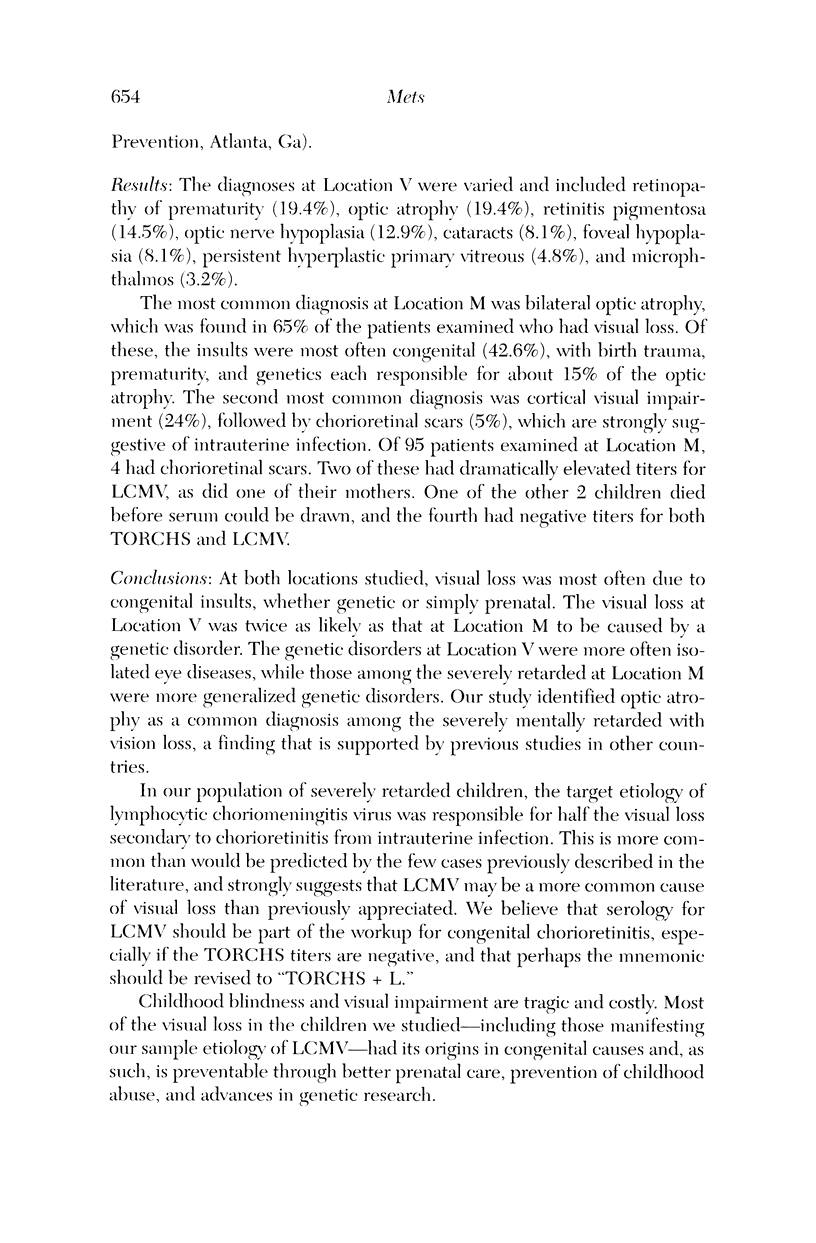

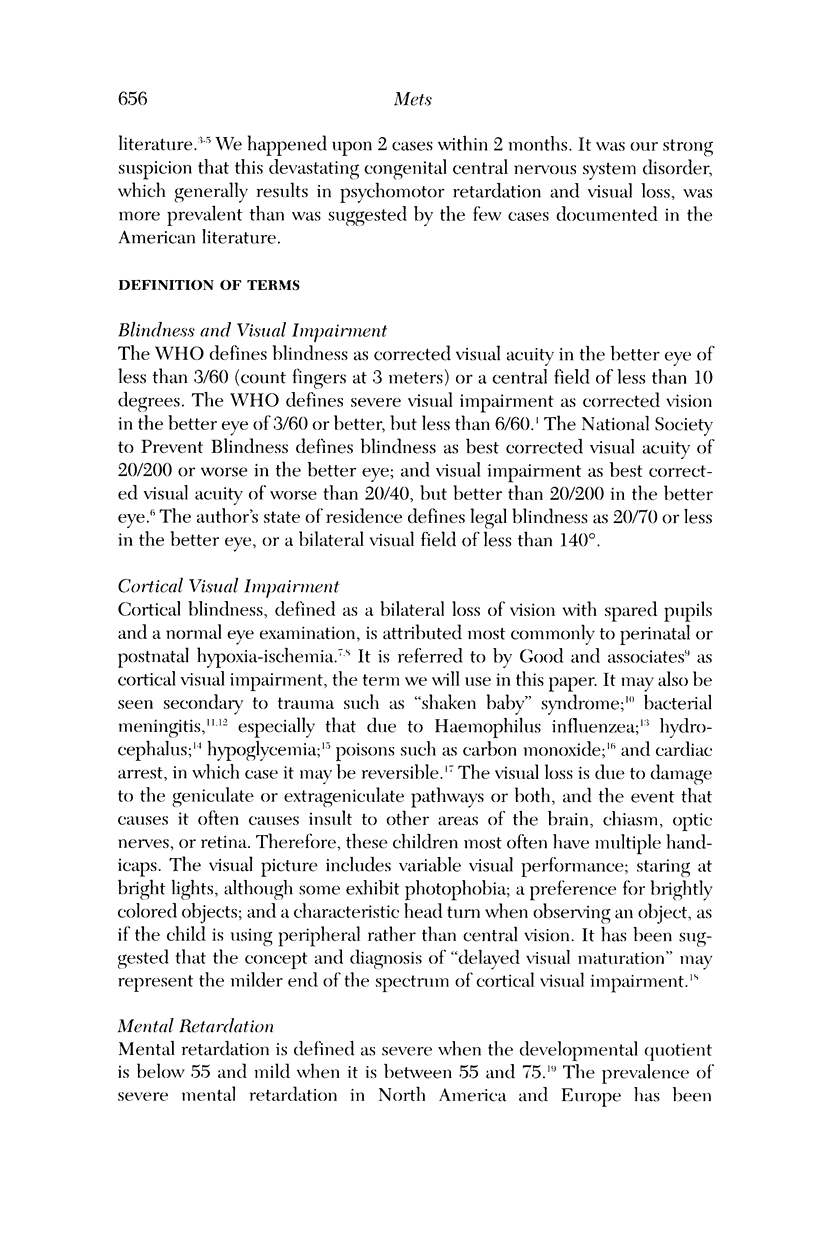

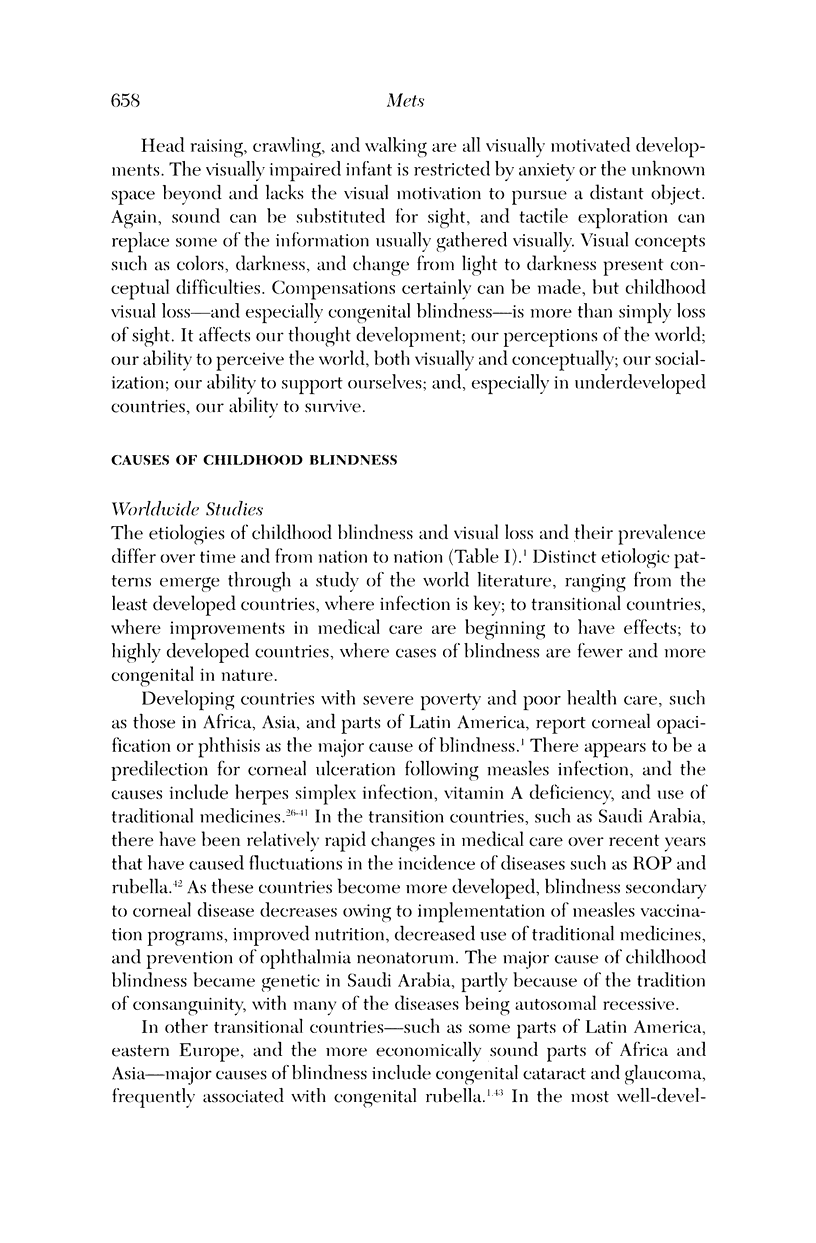
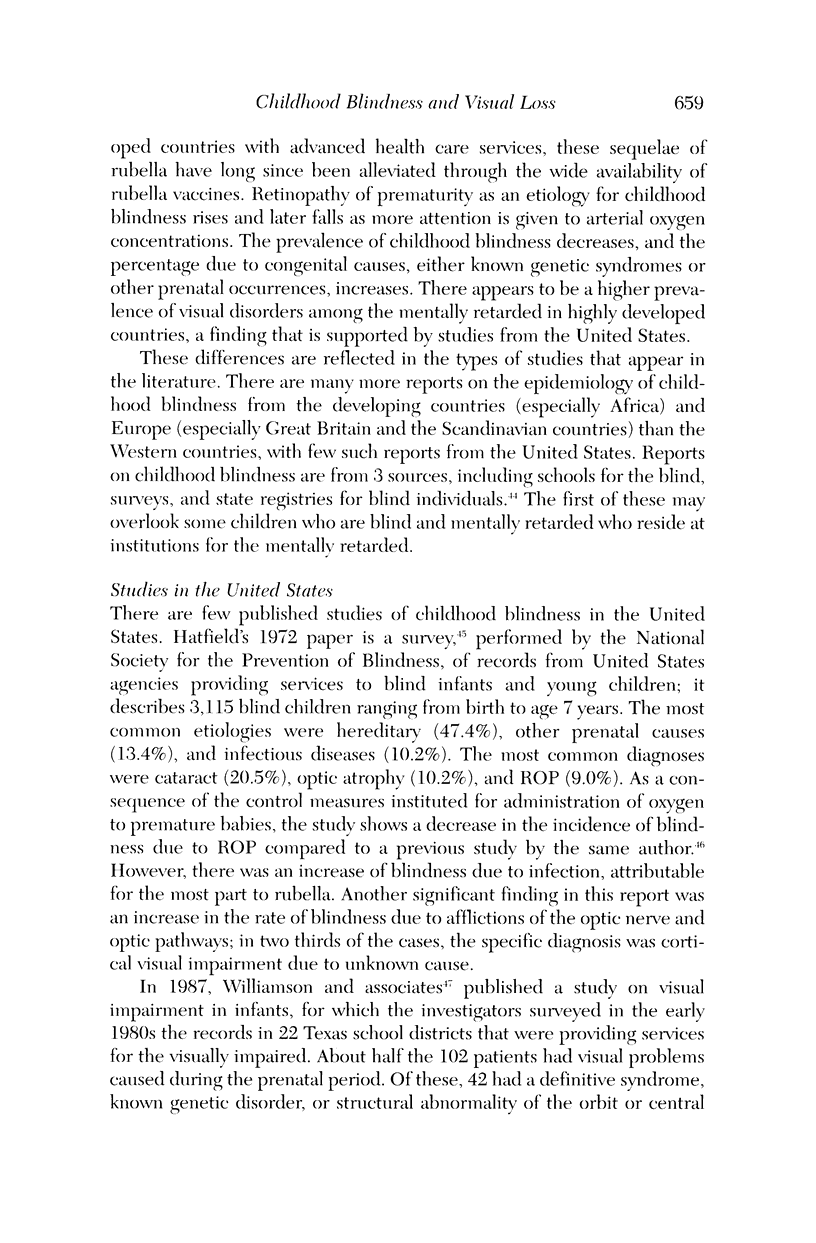
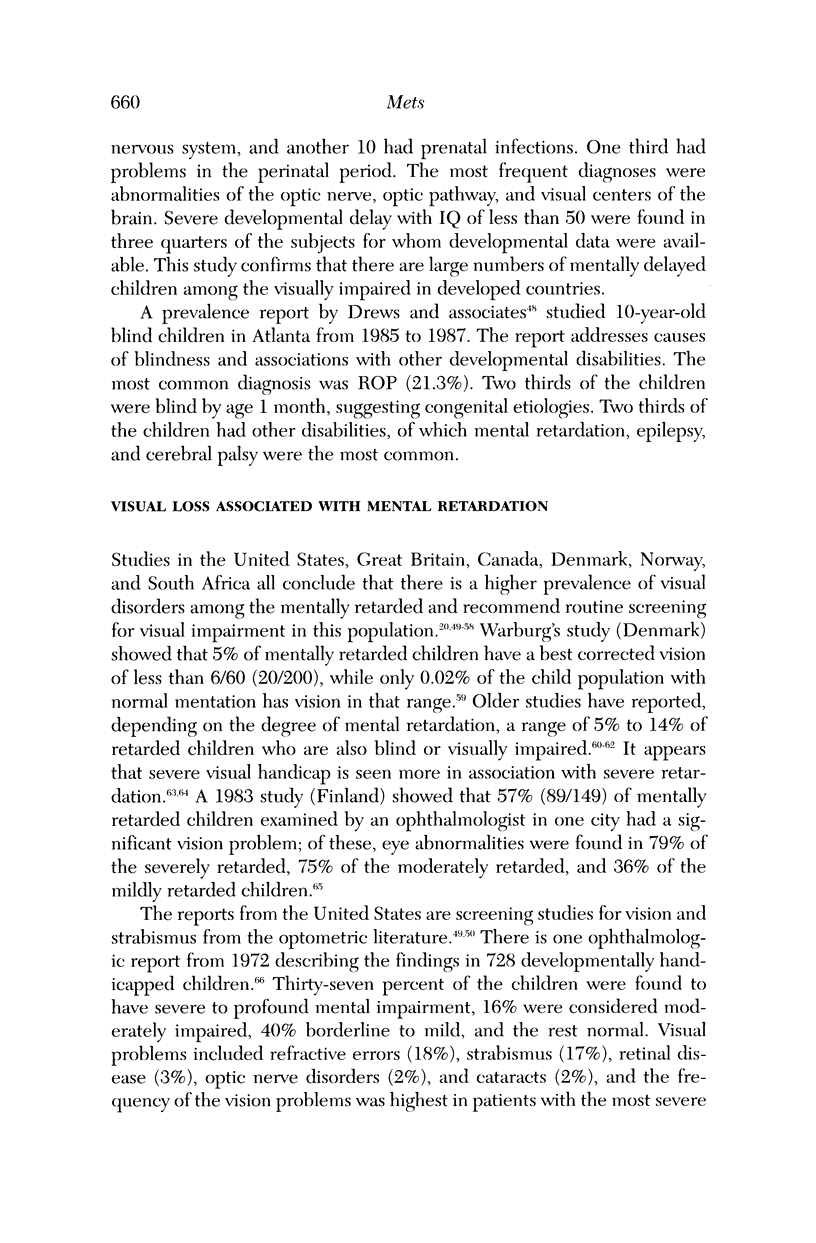
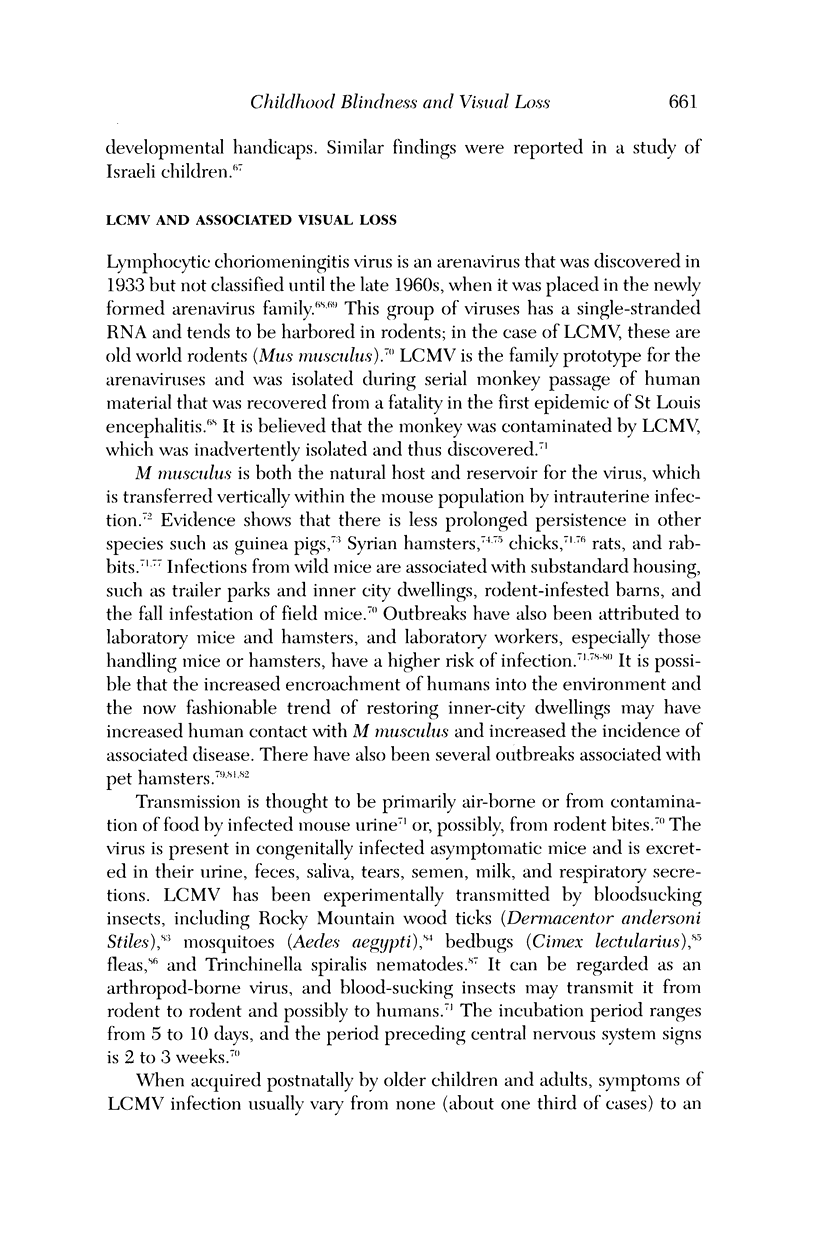
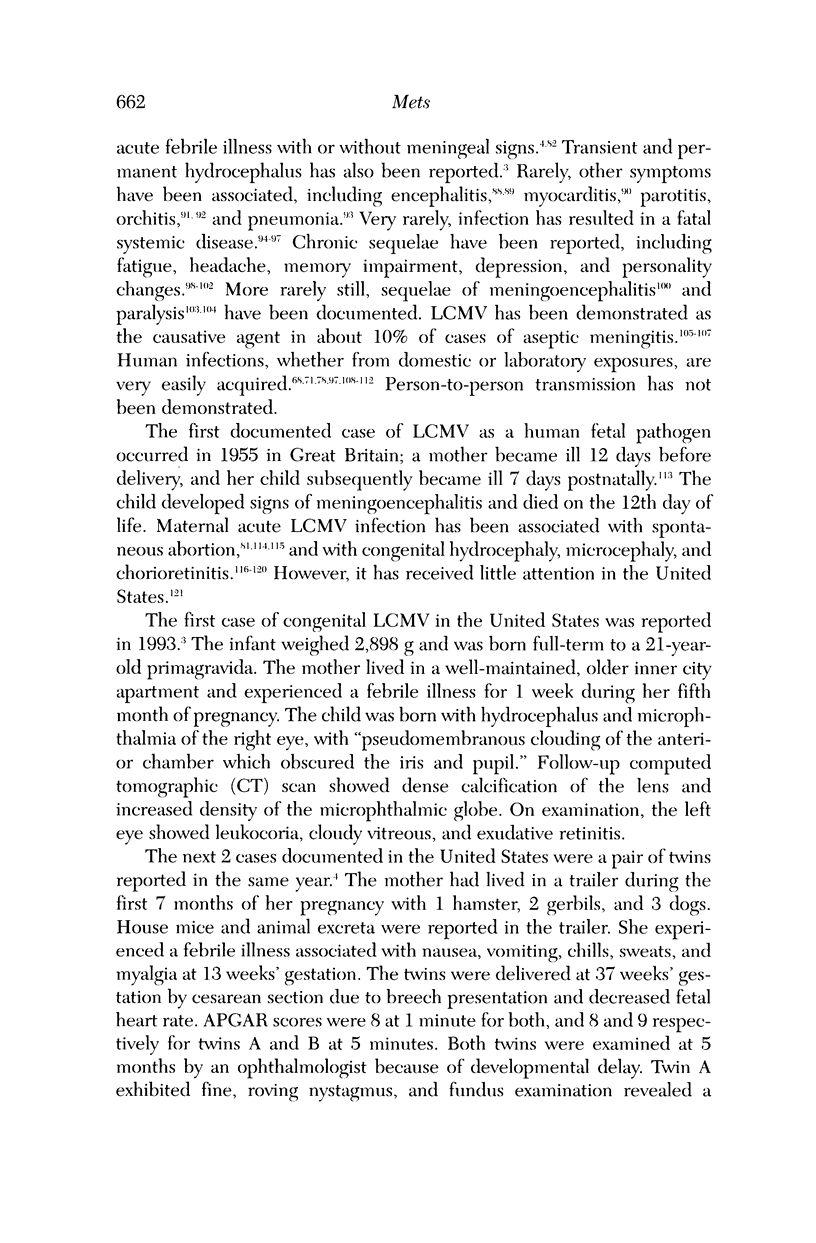
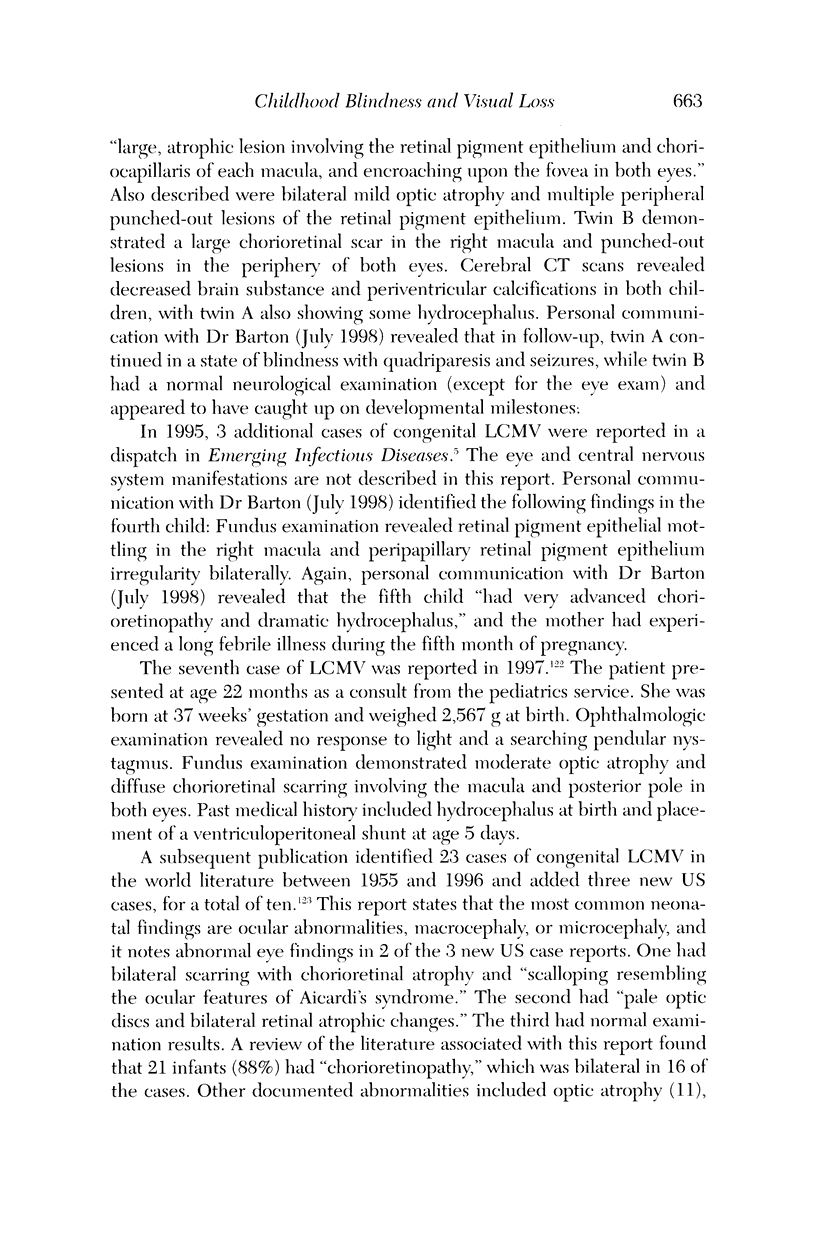
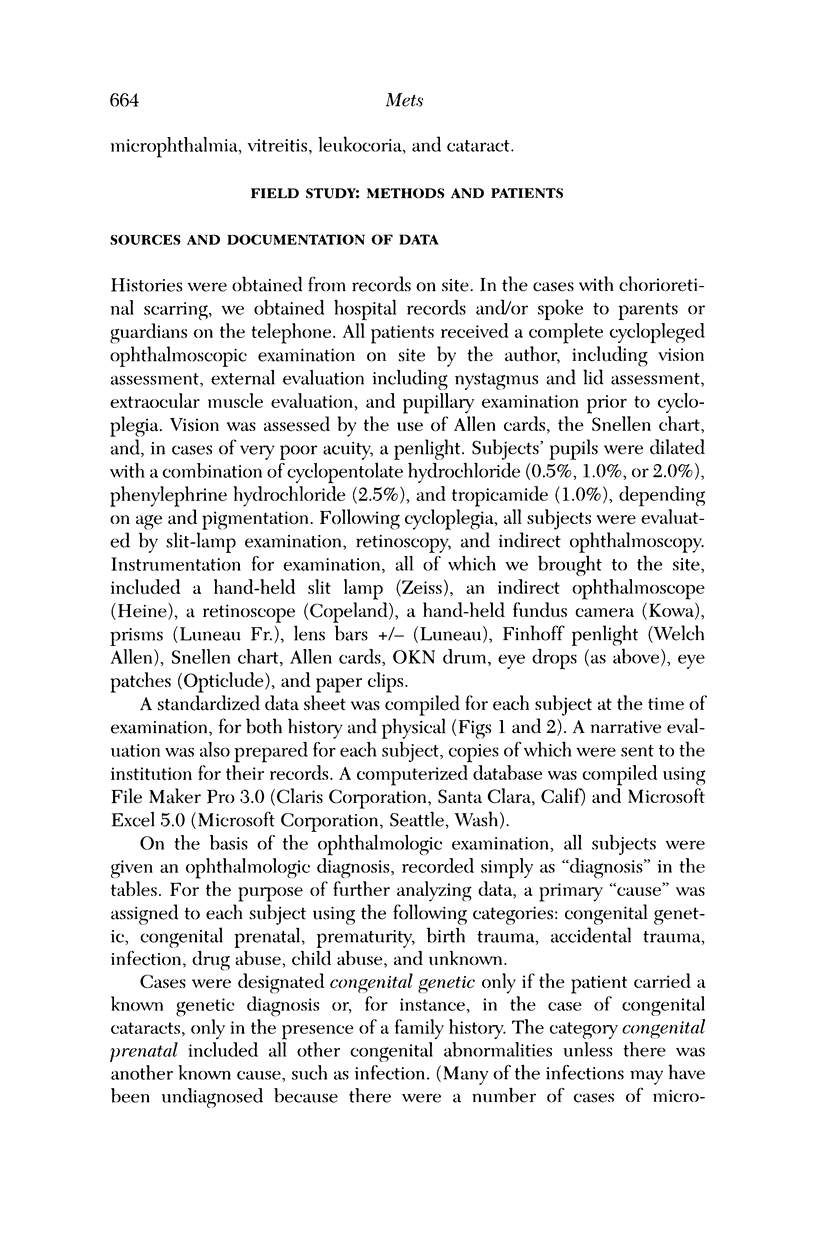

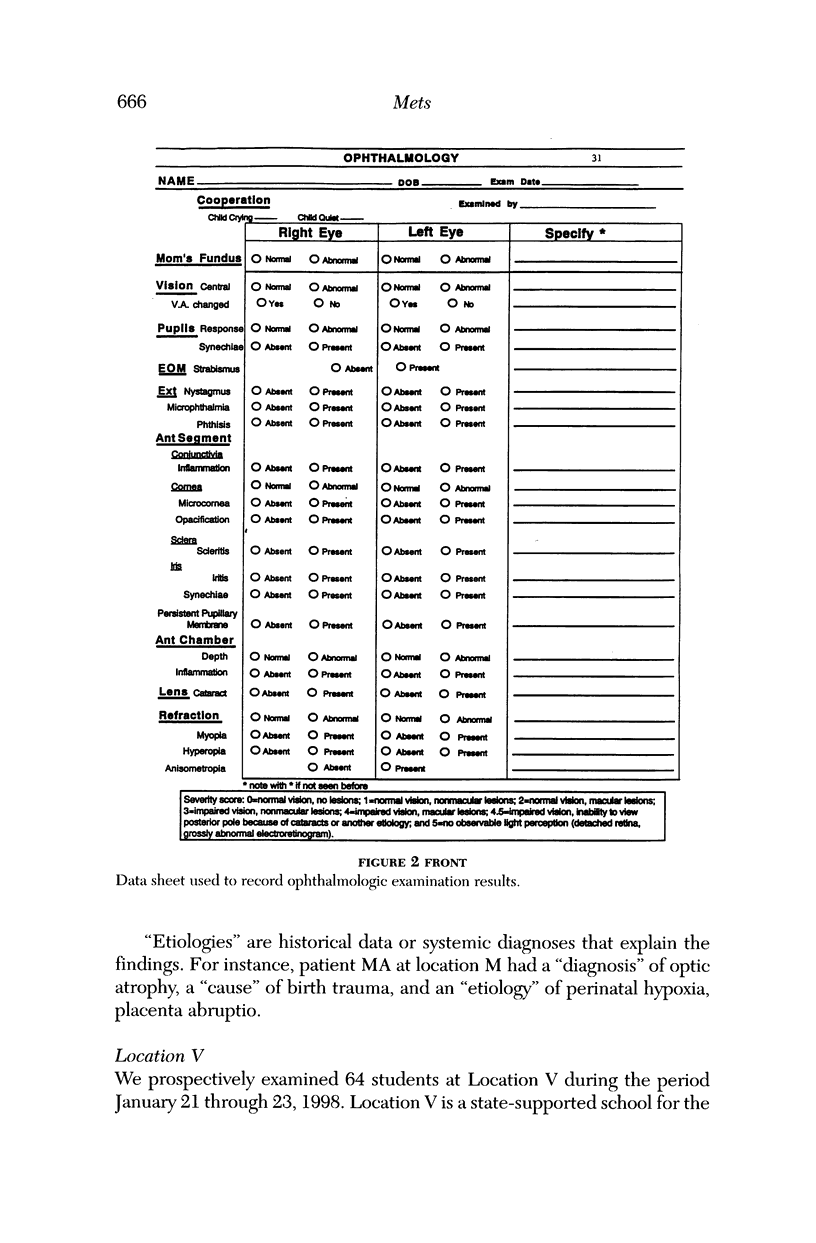
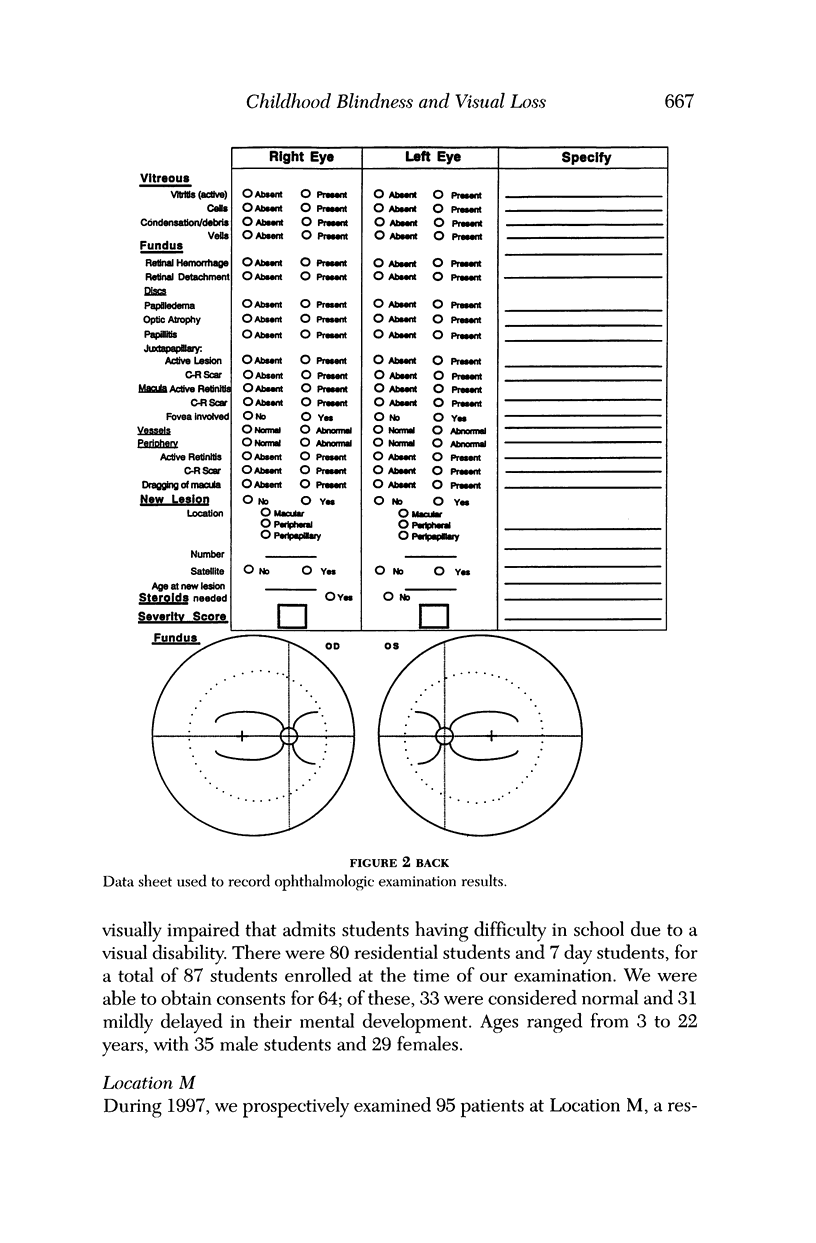
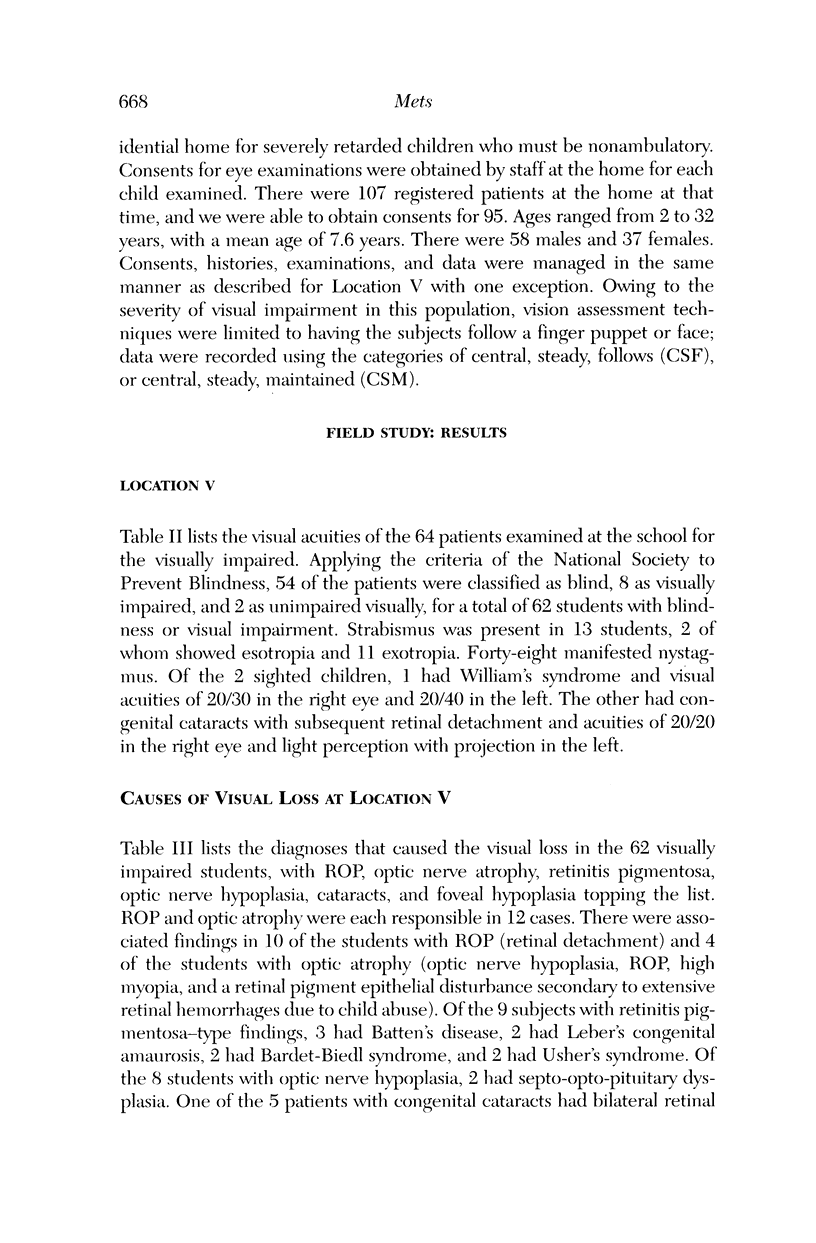
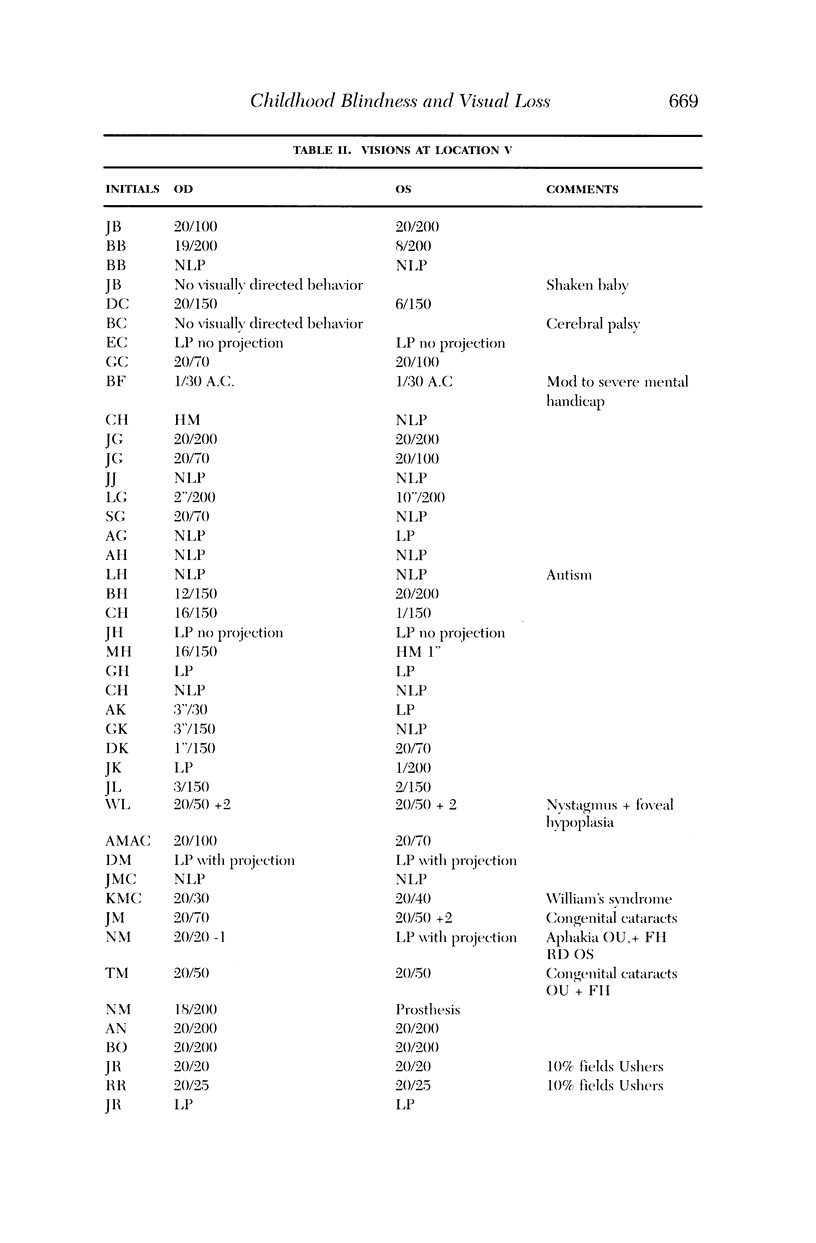

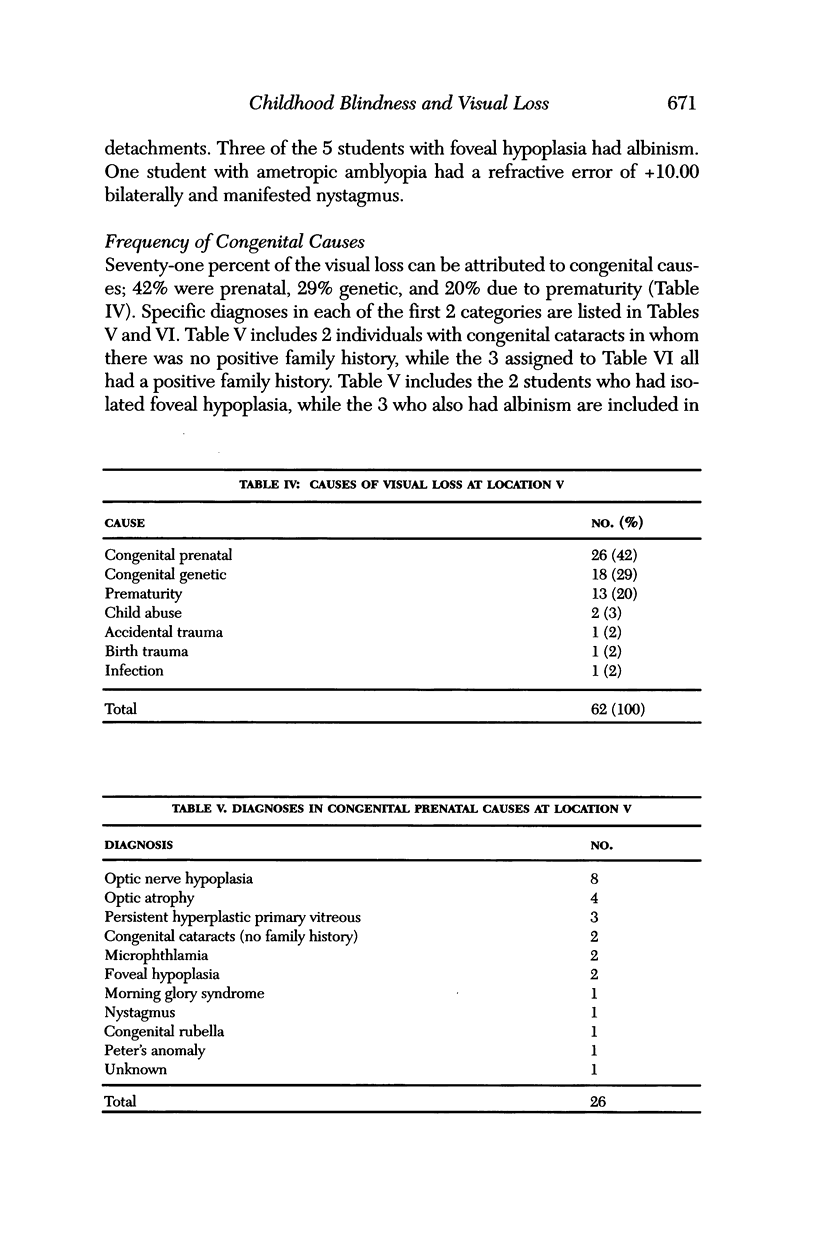
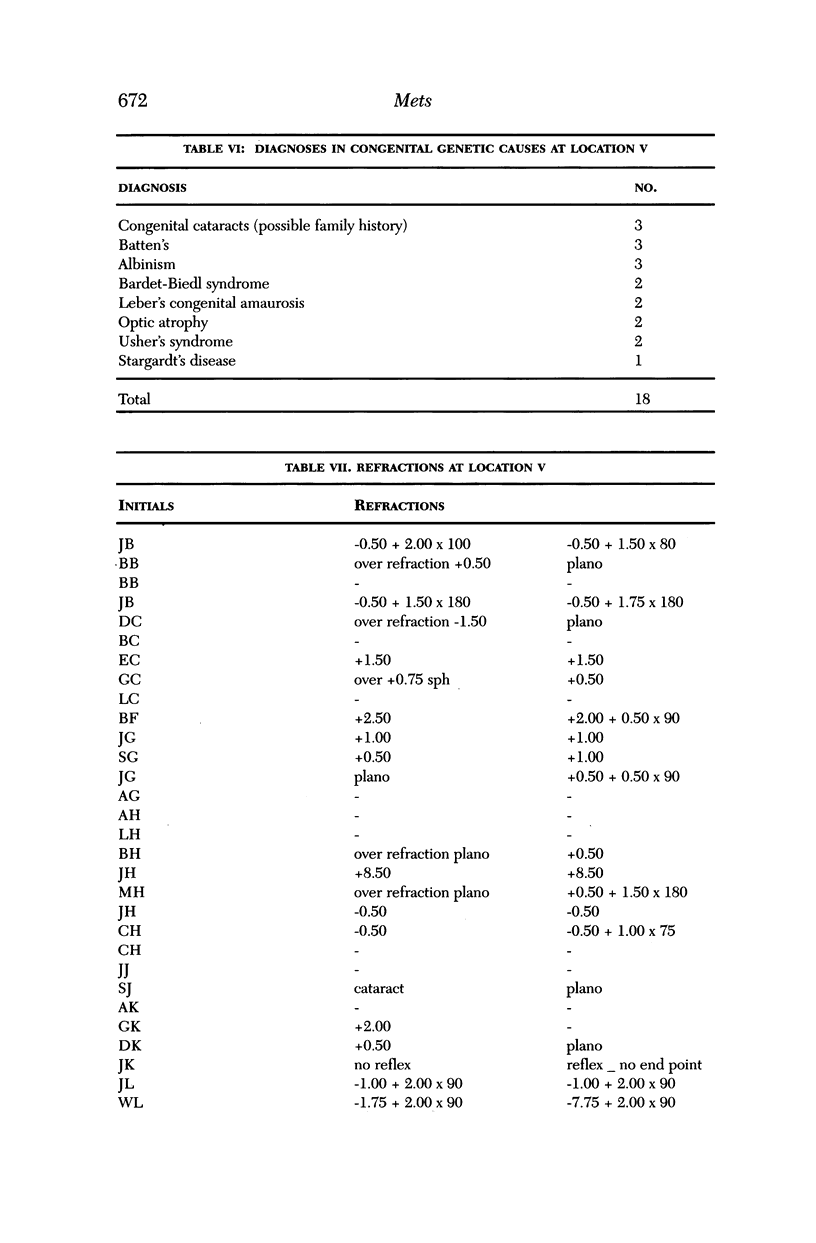

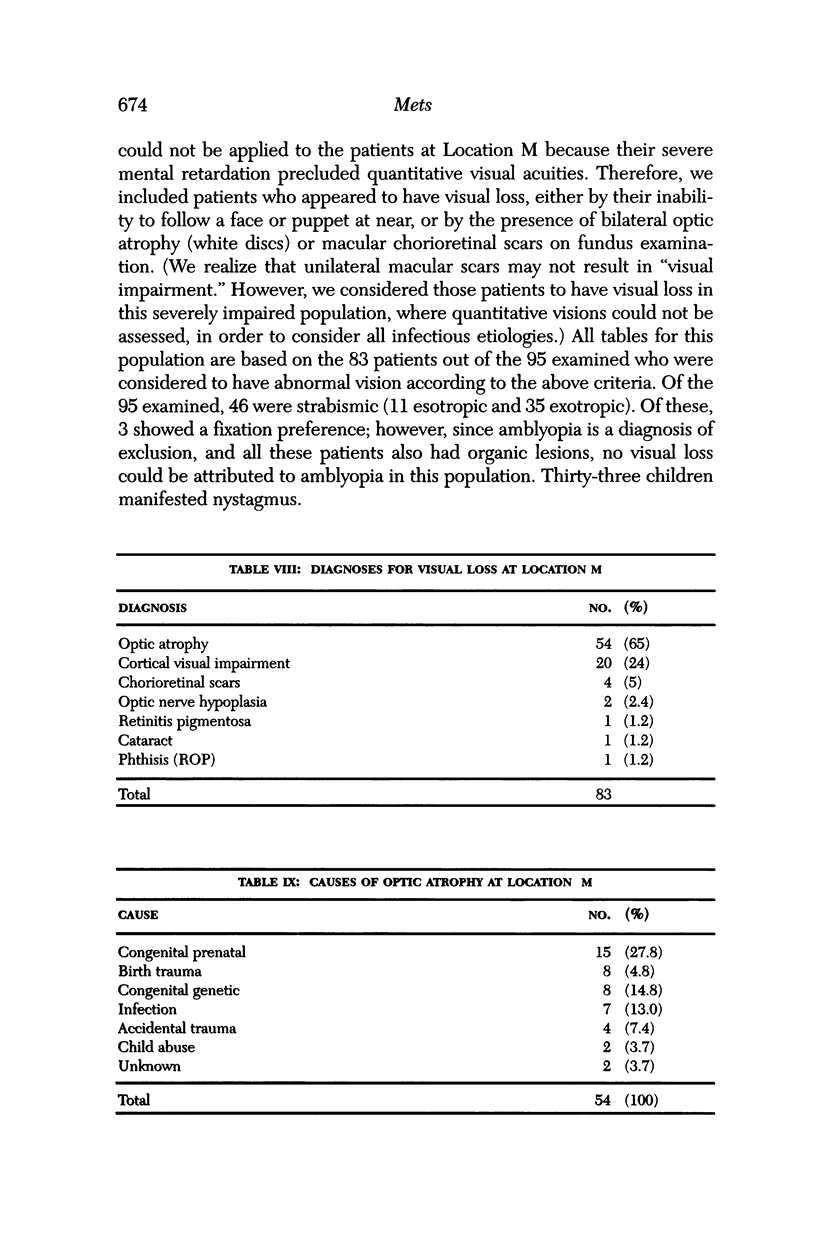
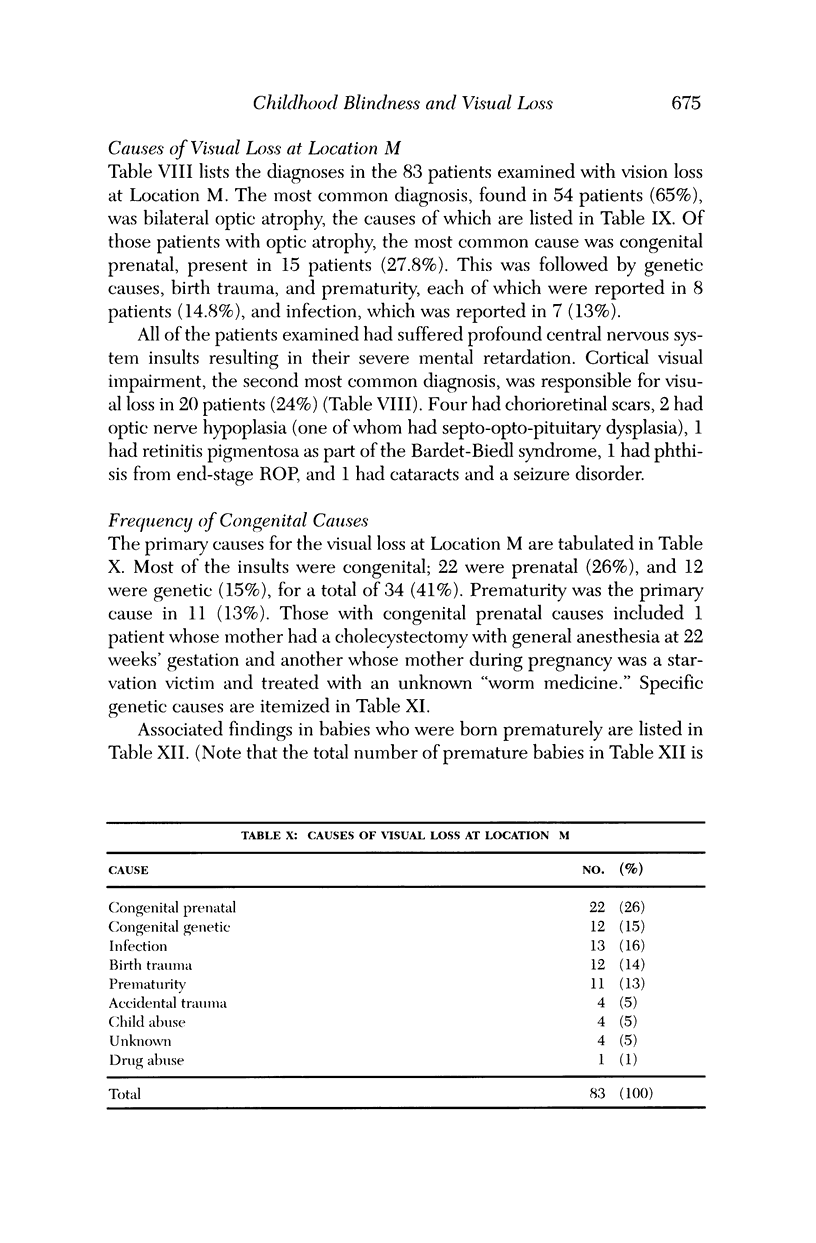
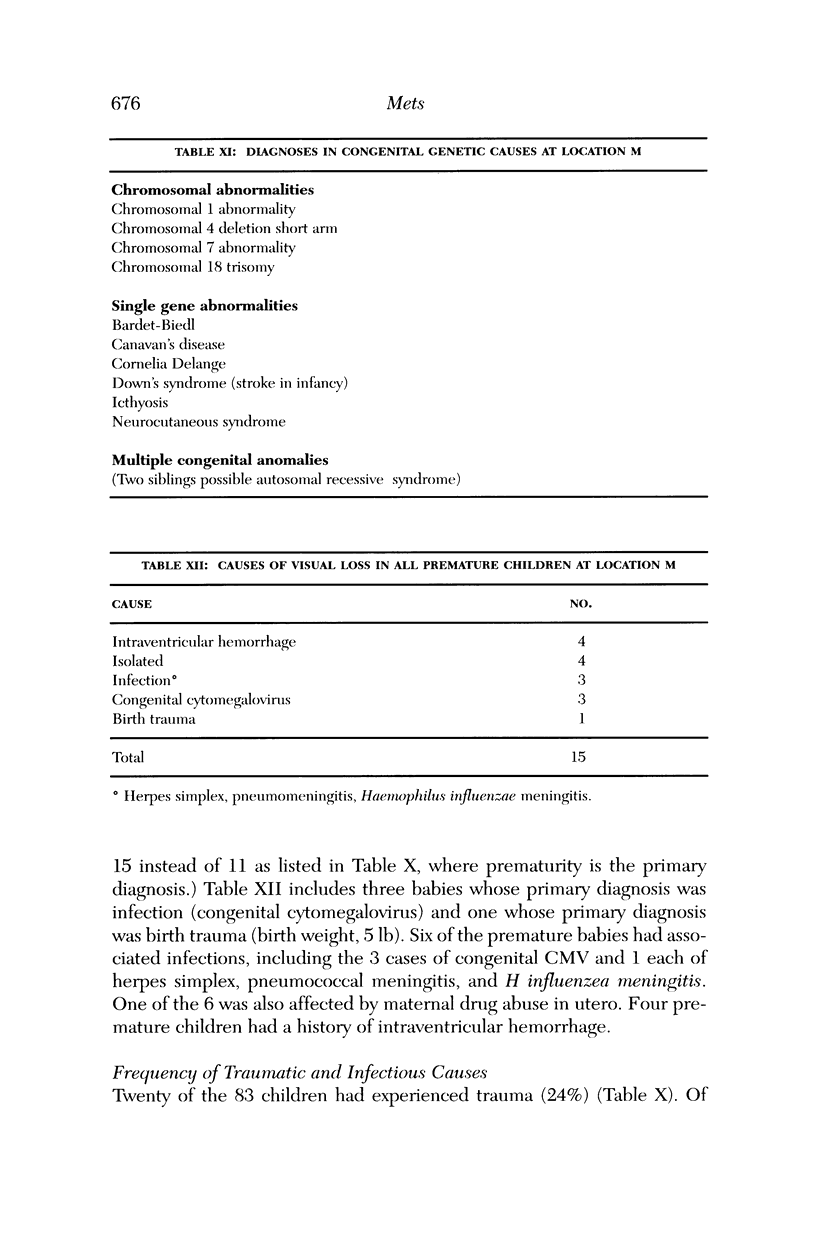


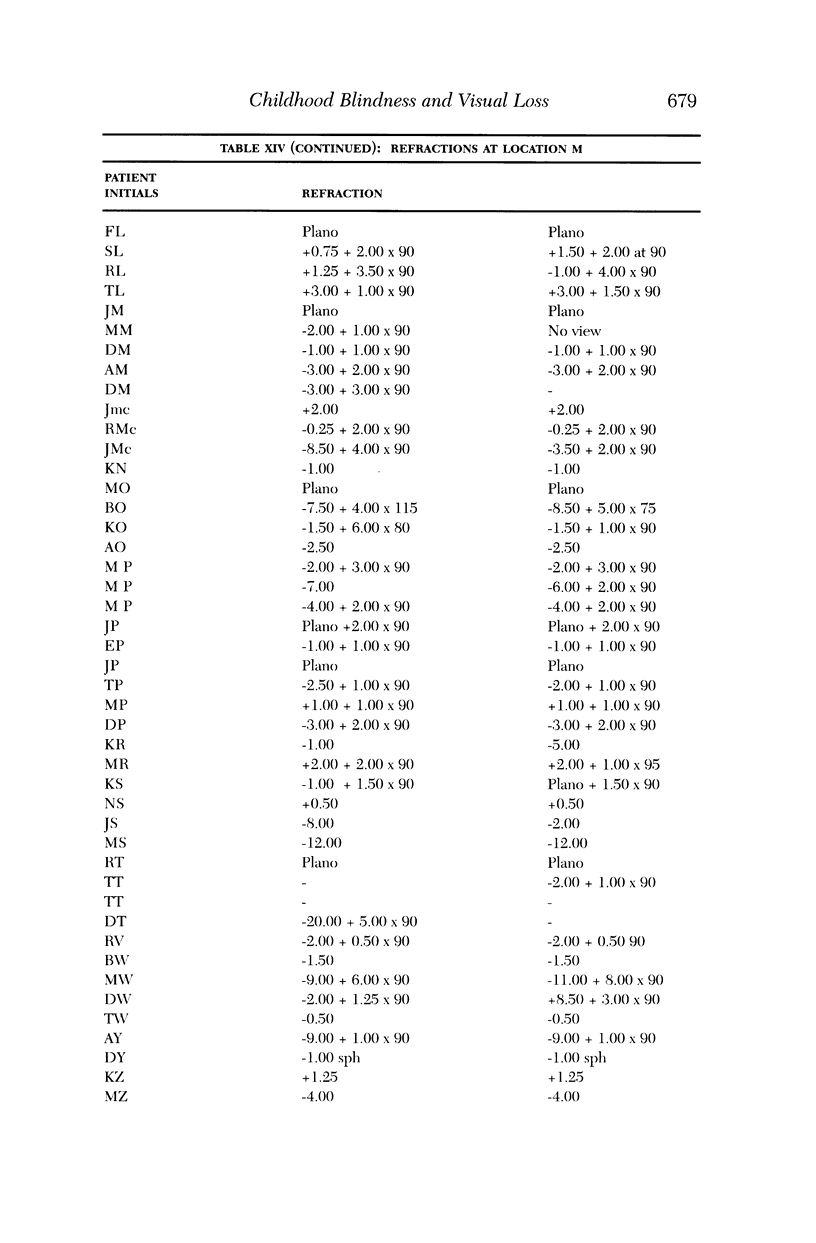
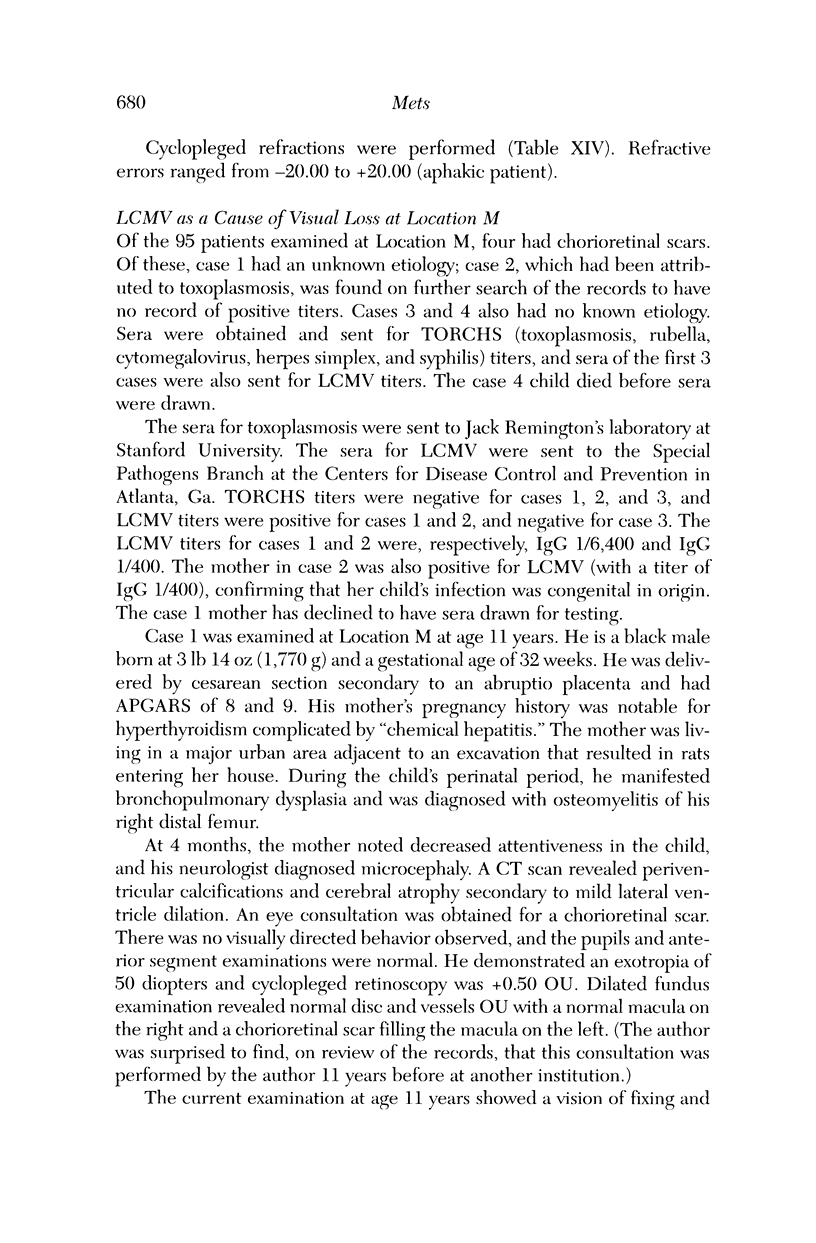

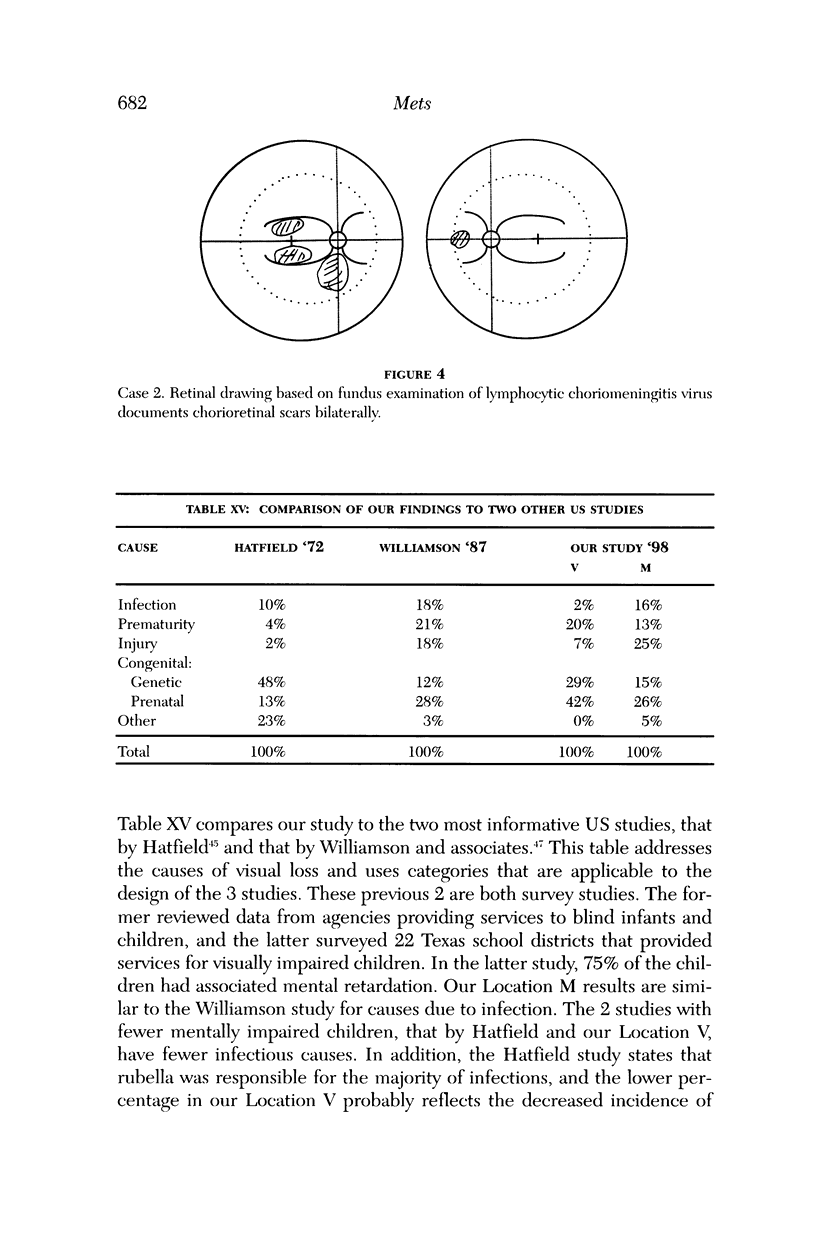
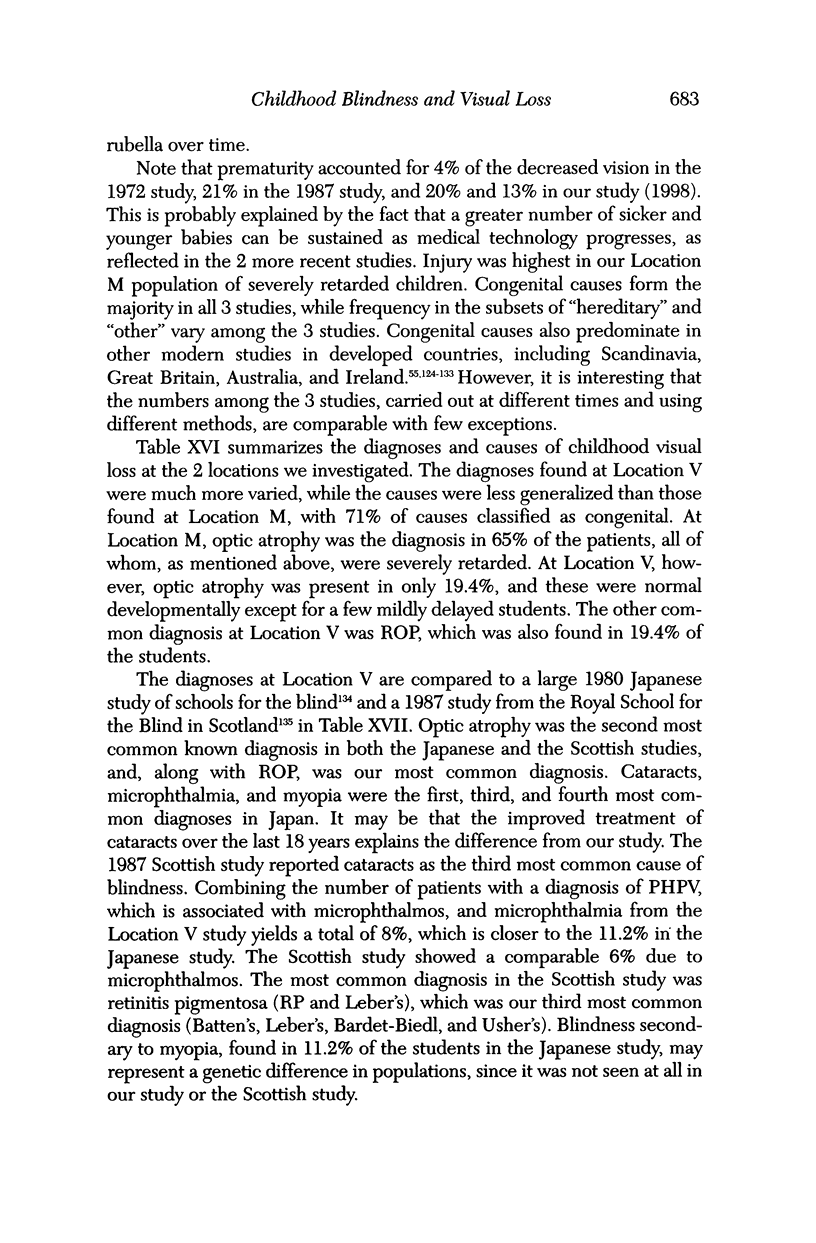
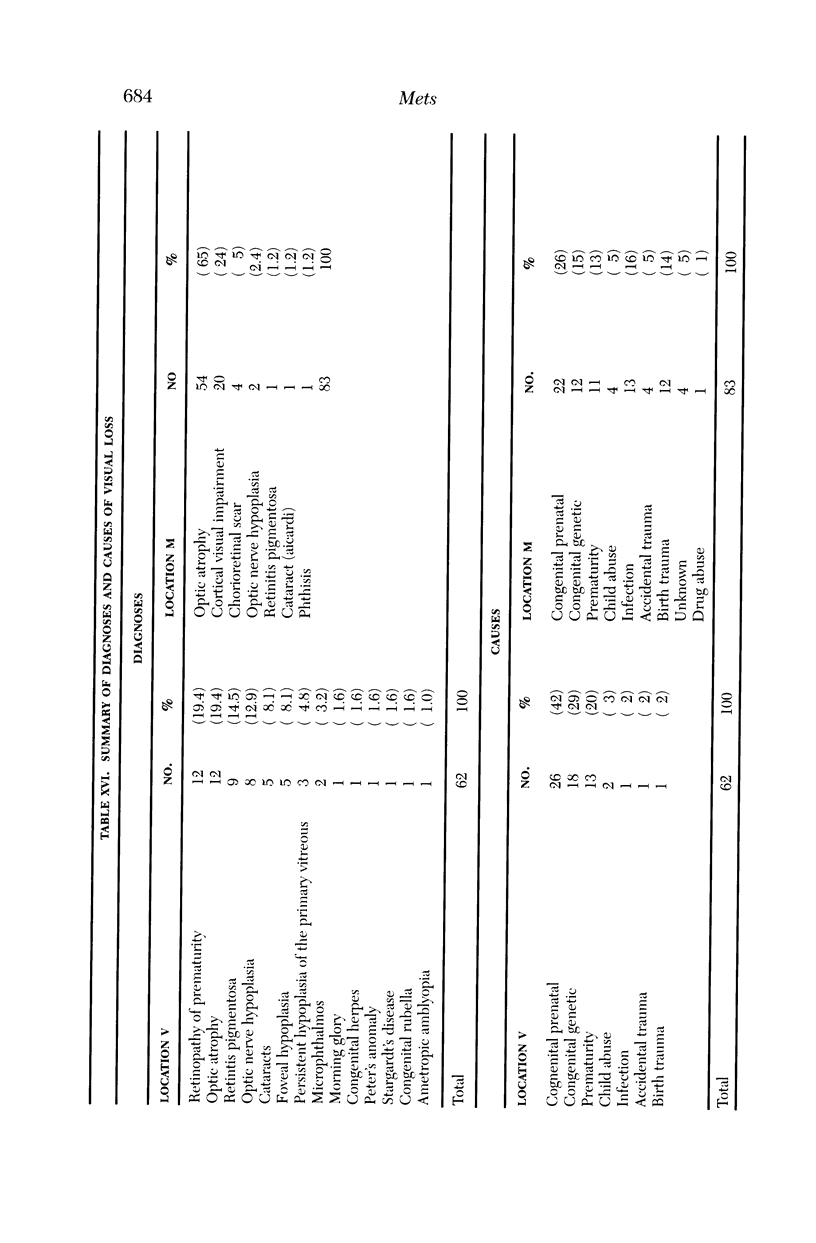
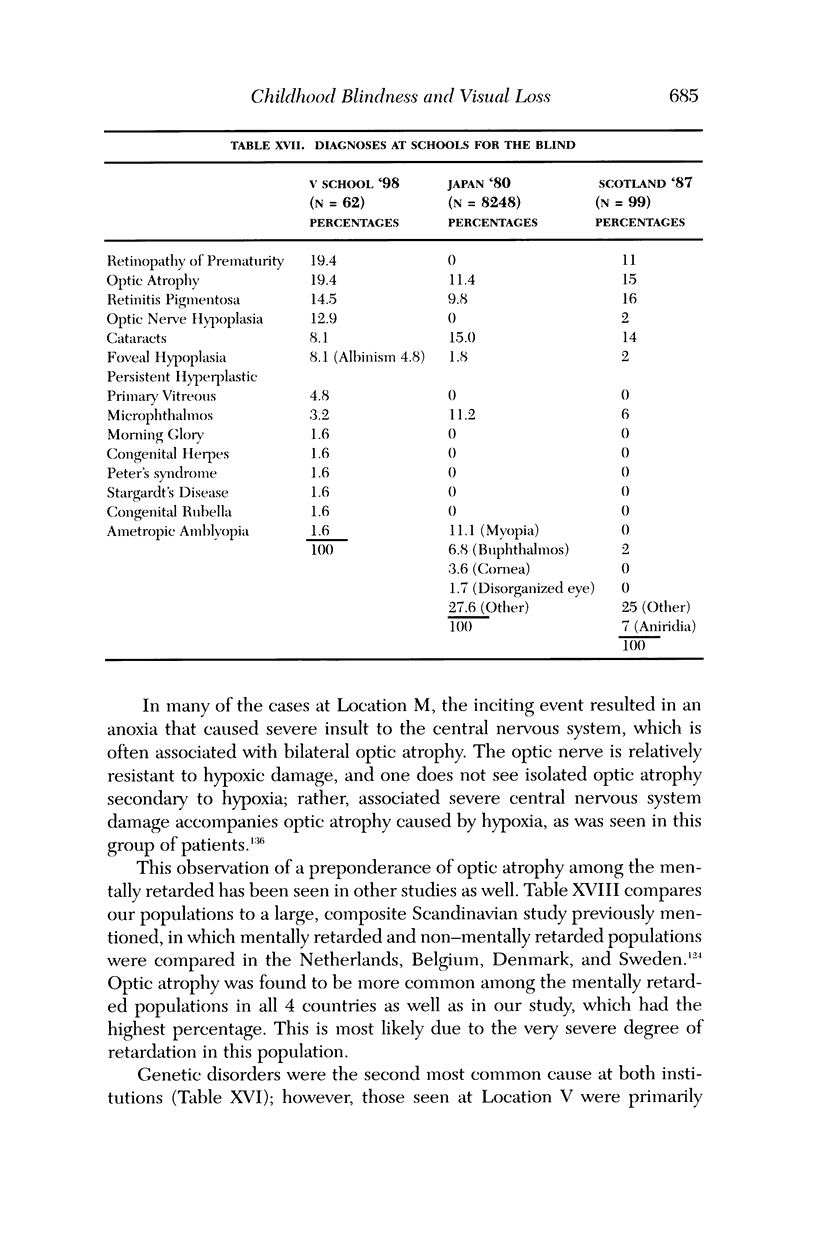
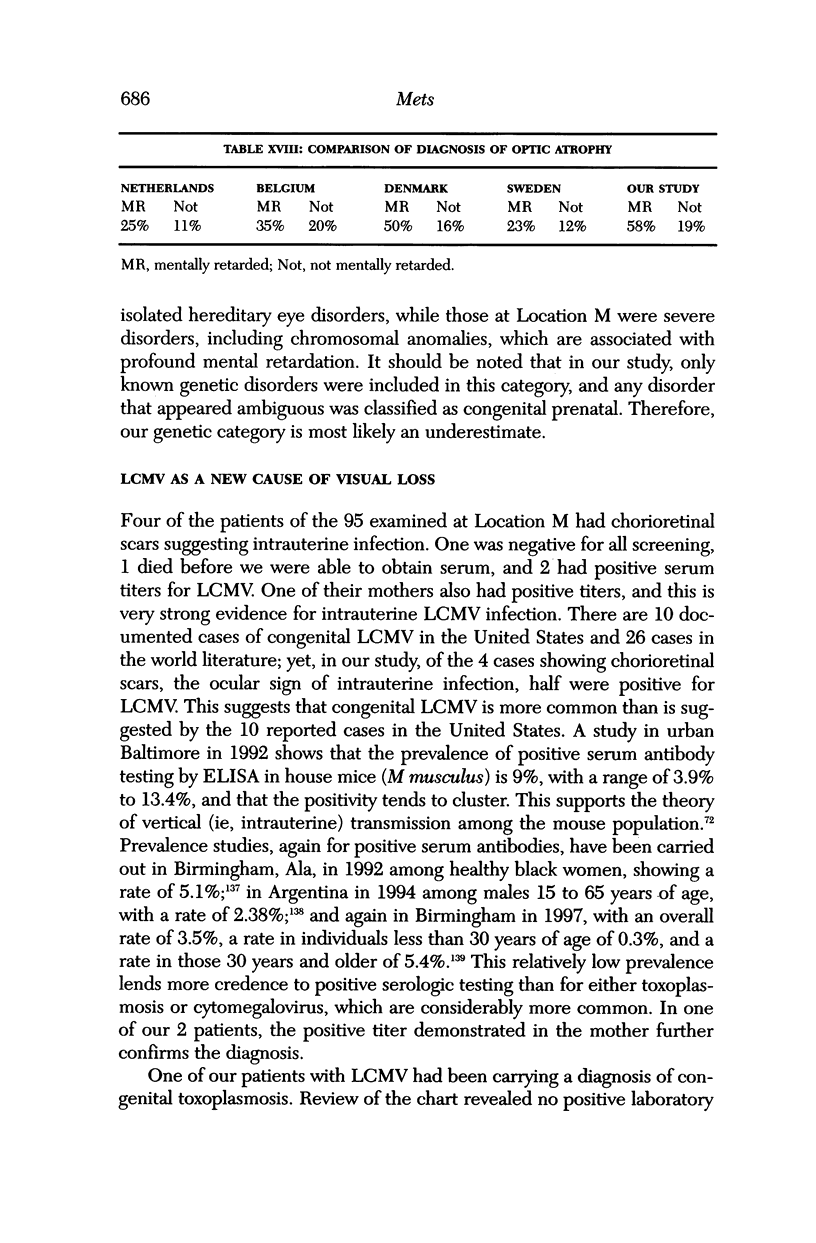
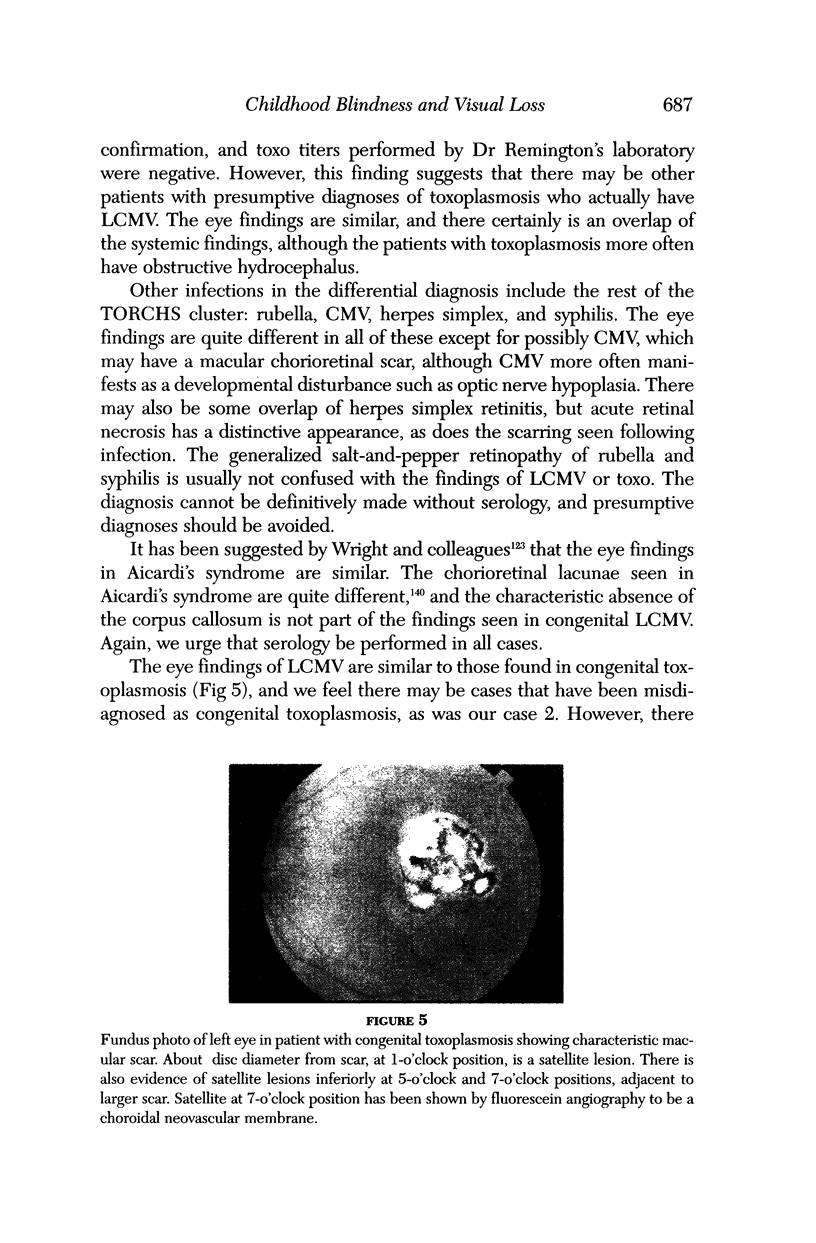
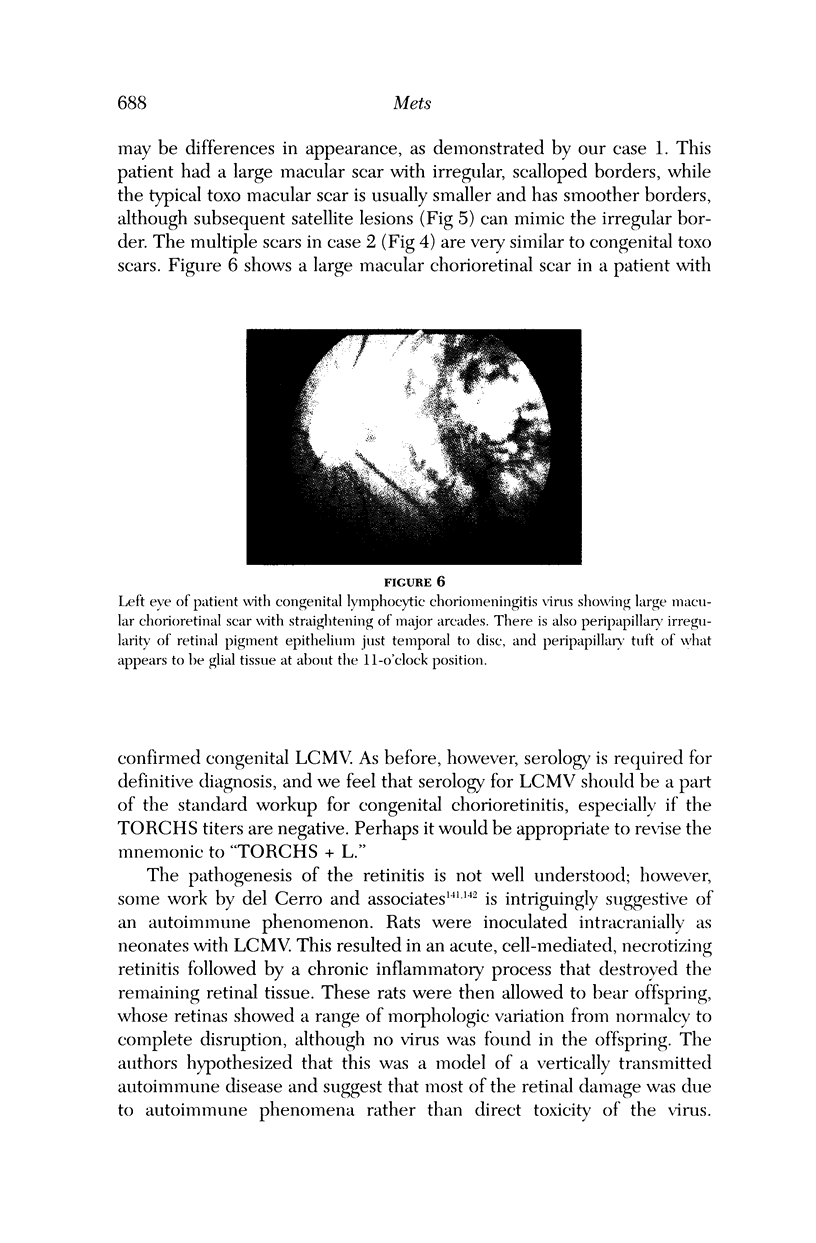
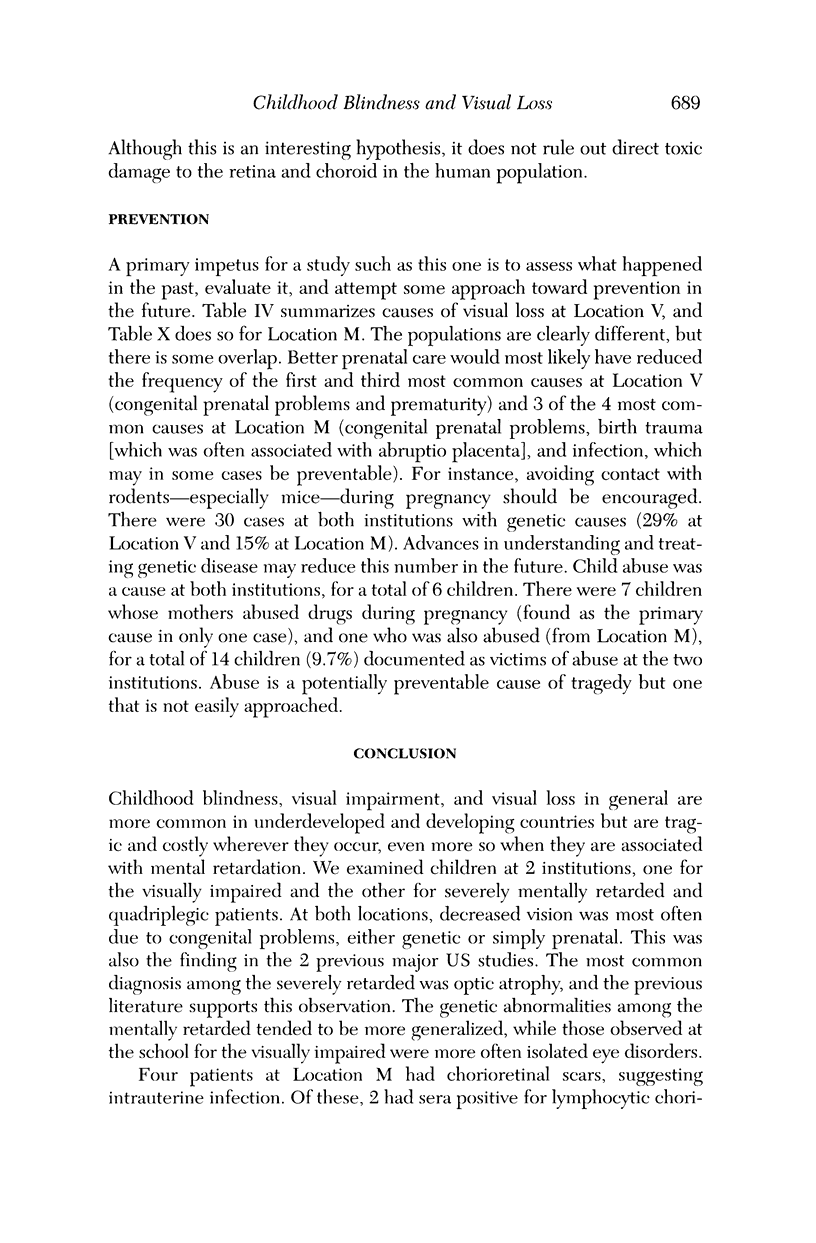
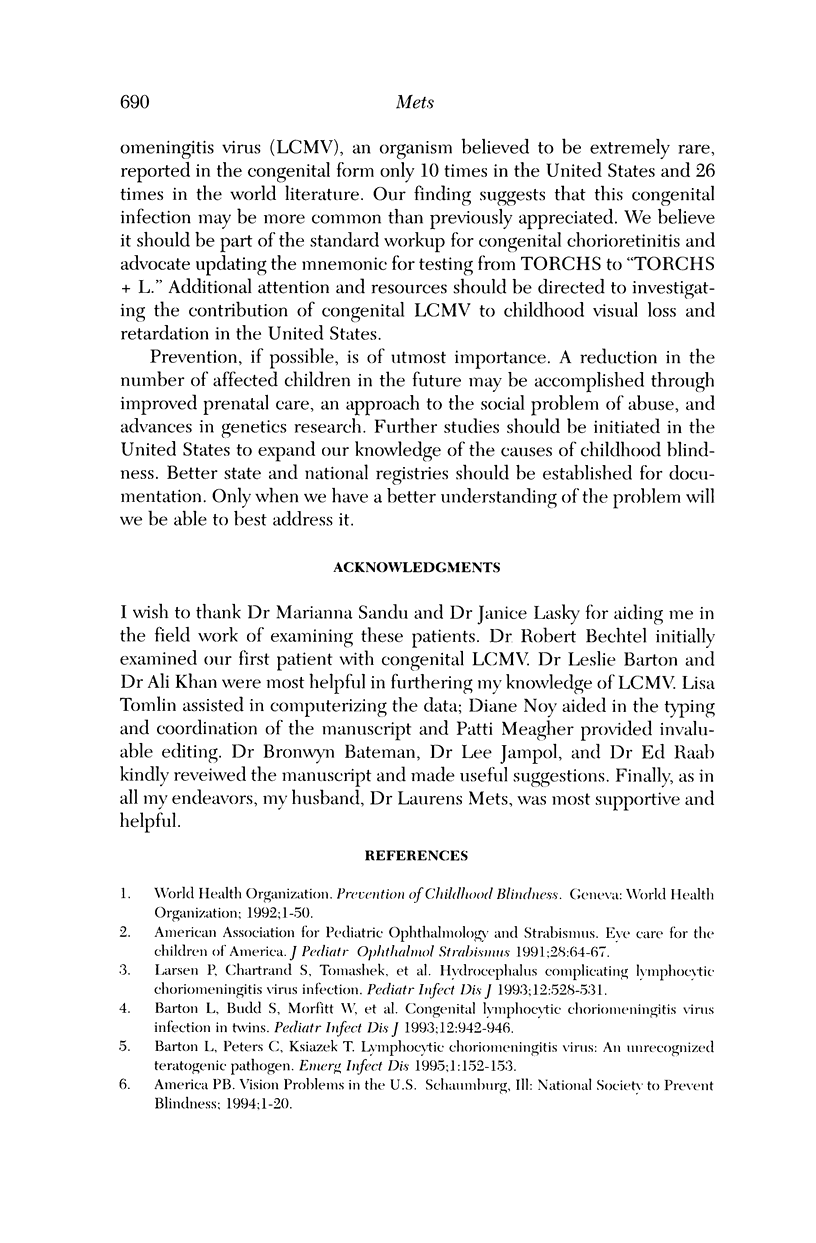

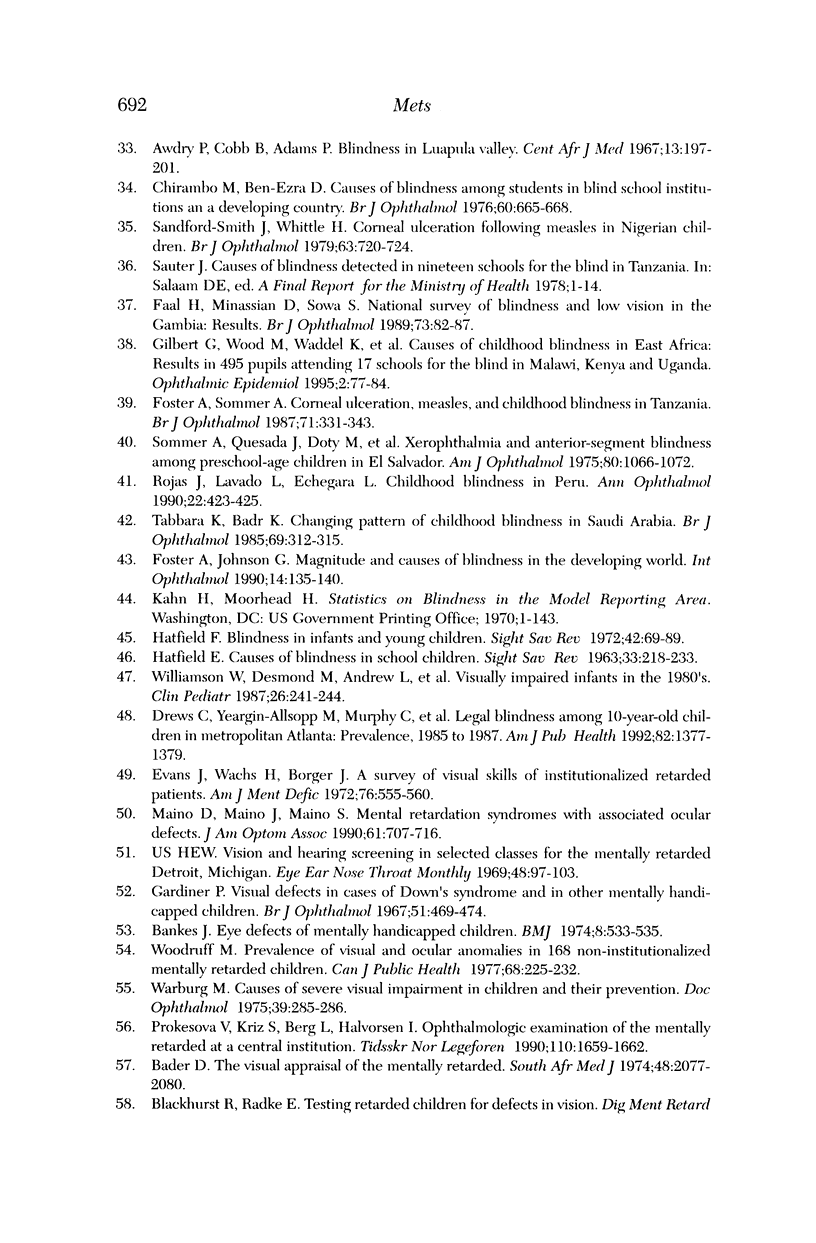

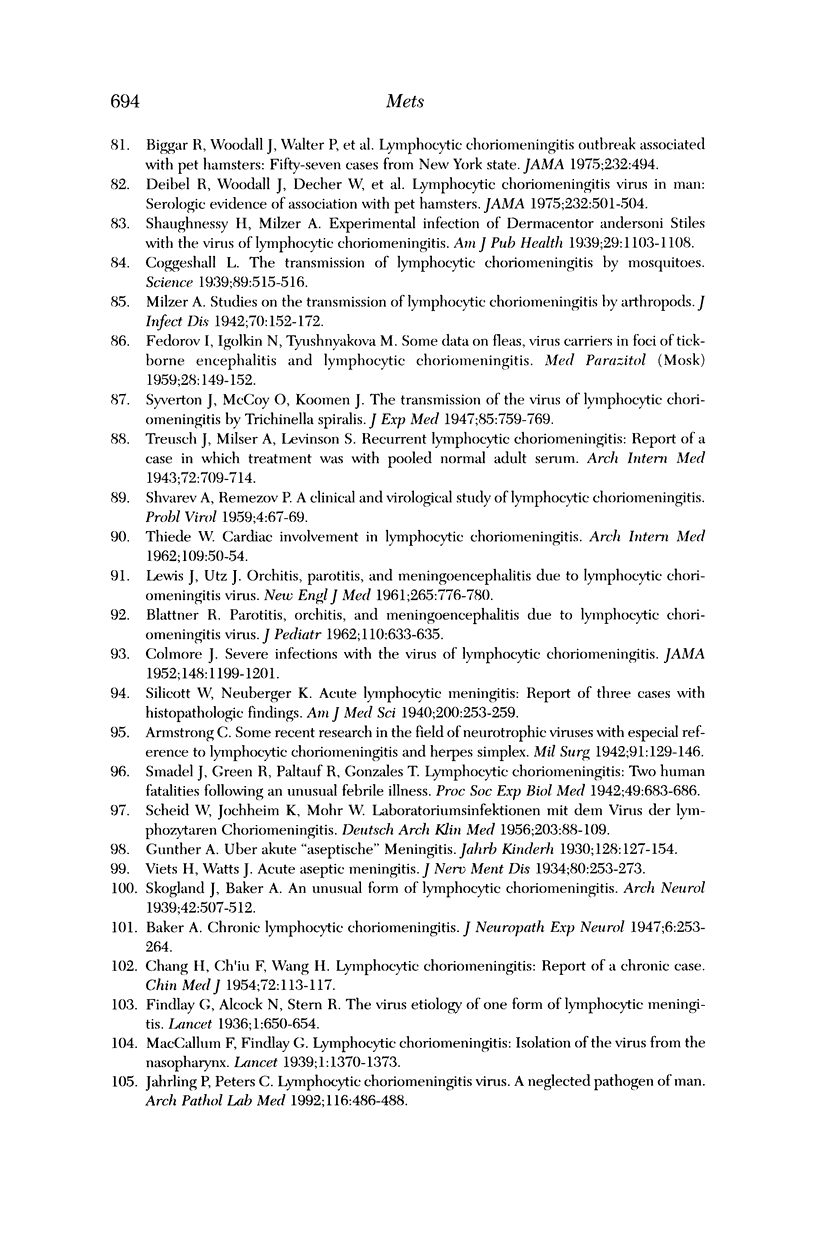
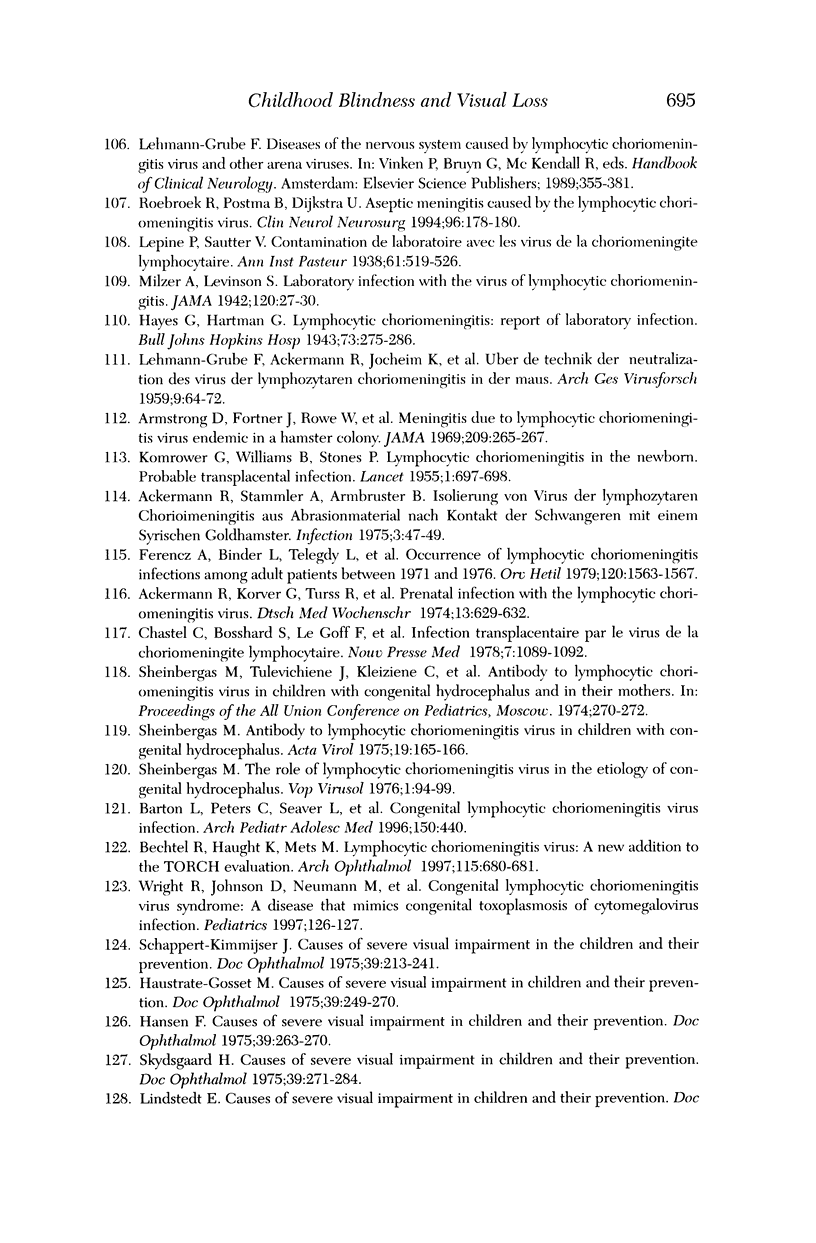
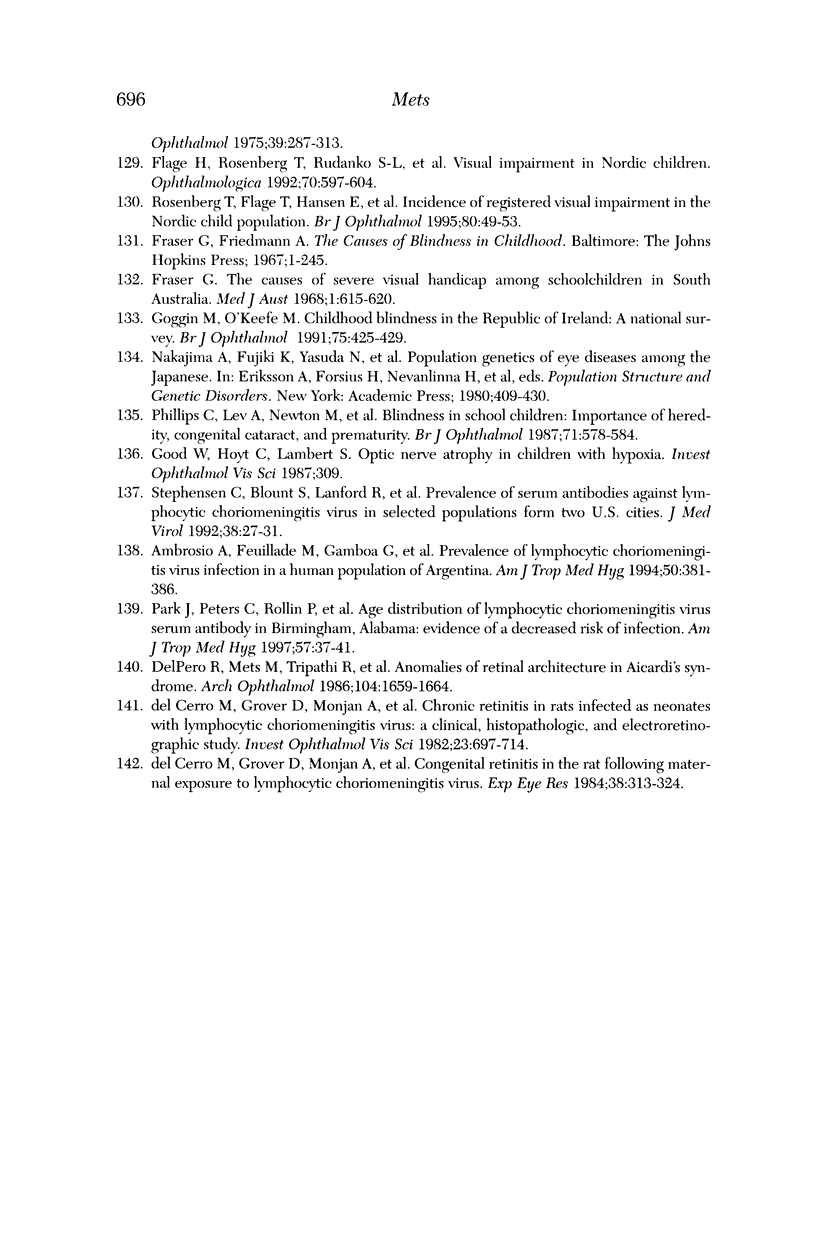
Images in this article
Selected References
These references are in PubMed. This may not be the complete list of references from this article.
- ACERS T. E., COOPER W. C. CORTICAL BLINDNESS SECONDARY TO BACTERIAL MENINGITIS. Am J Ophthalmol. 1965 Feb;59:226–229. [PubMed] [Google Scholar]
- Ackermann R., Körver G., Turss R., Wönne R., Hochgesand P. Pränatale Infektion mit dem Virus der Lymphozytären Choriomeningitis. Bericht über zwei Fälle. Dtsch Med Wochenschr. 1974 Mar 29;99(13):629–632. doi: 10.1055/s-0028-1107814. [DOI] [PubMed] [Google Scholar]
- Ackroyd R. S. Cortical blindness following bacterial meningitis: a case report with reassessment of prognosis and aetiology. Dev Med Child Neurol. 1984 Apr;26(2):227–230. doi: 10.1111/j.1469-8749.1984.tb04435.x. [DOI] [PubMed] [Google Scholar]
- Ambrosio A. M., Feuillade M. R., Gamboa G. S., Maiztegui J. I. Prevalence of lymphocytic choriomeningitis virus infection in a human population of Argentina. Am J Trop Med Hyg. 1994 Mar;50(3):381–386. doi: 10.4269/ajtmh.1994.50.381. [DOI] [PubMed] [Google Scholar]
- Armstrong D., Fortner J. G., Rowe W. P., Parker J. C. Meningitis due to lymphocytic choriomeningitis virus endemic in a hamster colony. JAMA. 1969 Jul 14;209(2):265–267. [PubMed] [Google Scholar]
- Arroyo H. A., Jan J. E., McCormick A. Q., Farrell K. Permanent visual loss after shunt malfunction. Neurology. 1985 Jan;35(1):25–29. doi: 10.1212/wnl.35.1.25. [DOI] [PubMed] [Google Scholar]
- Awdry P. N., Cobb B., Adams P. C. Blindness in the Luapula valley. Cent Afr J Med. 1967 Sep;13(9):197–201. [PubMed] [Google Scholar]
- BERG J. M., KIRMAN B. H. Some aetiological problems in mental deficiency. Br Med J. 1959 Oct 31;2(5156):848–852. doi: 10.1136/bmj.2.5156.848. [DOI] [PMC free article] [PubMed] [Google Scholar]
- BLANC G., BRUNEAU J. Comportement du virus de la chorioméningite chez la lapine en gestation. C R Hebd Seances Acad Sci. 1951 Dec 19;233(25):1704–1705. [PubMed] [Google Scholar]
- BLATTNER R. J. Parotitis, orchitis, and meningoencephalitis due to lymphocytic choriomeningitis virus. J Pediatr. 1962 Apr;60:633–635. doi: 10.1016/s0022-3476(62)80128-0. [DOI] [PubMed] [Google Scholar]
- Bader D. The visual appraisal of the mentally retarded. S Afr Med J. 1974 Oct 12;48(49):2077–2080. [PubMed] [Google Scholar]
- Bankes J. L. Eye defects of mentally handicapped children. Br Med J. 1974 Jun 8;2(5918):533–535. doi: 10.1136/bmj.2.5918.533. [DOI] [PMC free article] [PubMed] [Google Scholar]
- Barton L. L., Budd S. C., Morfitt W. S., Peters C. J., Ksiazek T. G., Schindler R. F., Yoshino M. T. Congenital lymphocytic choriomeningitis virus infection in twins. Pediatr Infect Dis J. 1993 Nov;12(11):942–946. doi: 10.1097/00006454-199311000-00010. [DOI] [PubMed] [Google Scholar]
- Barton L. L., Peters C. J., Ksiazek T. G. Lymphocytic choriomeningitis virus: an unrecognized teratogenic pathogen. Emerg Infect Dis. 1995 Oct-Dec;1(4):152–153. doi: 10.3201/eid0104.950410. [DOI] [PMC free article] [PubMed] [Google Scholar]
- Barton L. L., Peters C. J., Seaver L. H., Chartrand S. A. Congenital lymphocytic choriomeningitis virus infection. Arch Pediatr Adolesc Med. 1996 Apr;150(4):440–440. doi: 10.1001/archpedi.1996.02170290106019. [DOI] [PubMed] [Google Scholar]
- Baum S. G., Lewis A. M., Jr, Rowe W. P., Huebner R. J. Epidemic nonmeningitic lymphocytic-choriomeningitis-virus infection. An outbreak in a population of laboratory personnel. N Engl J Med. 1966 Apr 28;274(17):934–936. doi: 10.1056/NEJM196604282741704. [DOI] [PubMed] [Google Scholar]
- Bechtel R. T., Haught K. A., Mets M. B. Lymphocytic choriomeningitis virus: a new addition to the TORCH evaluation. Arch Ophthalmol. 1997 May;115(5):680–681. doi: 10.1001/archopht.1997.01100150682027. [DOI] [PubMed] [Google Scholar]
- Biggar R. J., Woodall J. P., Walter P. D., Haughie G. E. Lymphocytic choriomeningitis outbreak associated with pet hamsters. Fifty-seven cases from New York State;. JAMA. 1975 May 5;232(5):494–500. [PubMed] [Google Scholar]
- CHANG H. T., CH'IU F. H., WANG H. C. Lymphocytic choriomeningitis; report of a chronic case. Chin Med J. 1954 Mar-Apr;72(2):113–117. [PubMed] [Google Scholar]
- COLMORE J. P. Severe infections with the virus of lymphocytic choriomeningitis. J Am Med Assoc. 1952 Apr 5;148(14):1199–1201. doi: 10.1001/jama.1952.02930140031008. [DOI] [PubMed] [Google Scholar]
- Causes of severe visual impairment in children and their prevention. Doc Ophthalmol. 1975 Dec 30;39(2):213–341. [PubMed] [Google Scholar]
- Chastel C., Bosshard S., Le Goff F., Quillien M. C., Gilly R., Aymard M. Infection transplacentaire par le virus de la chorioméningite lymphocytaire. Résultats d'une enquête sérologique rétrospective en France. Nouv Presse Med. 1978 Apr 1;7(13):1089–1092. [PubMed] [Google Scholar]
- Chiang Y. P., Bassi L. J., Javitt J. C. Federal budgetary costs of blindness. Milbank Q. 1992;70(2):319–340. [PubMed] [Google Scholar]
- Childs J. E., Glass G. E., Korch G. W., Ksiazek T. G., Leduc J. W. Lymphocytic choriomeningitis virus infection and house mouse (Mus musculus) distribution in urban Baltimore. Am J Trop Med Hyg. 1992 Jul;47(1):27–34. doi: 10.4269/ajtmh.1992.47.27. [DOI] [PubMed] [Google Scholar]
- Chirambo M. C., Benezra D. Causes of blindness among students in blind school institutions in a developing country. Br J Ophthalmol. 1976 Sep;60(9):665–668. doi: 10.1136/bjo.60.9.665. [DOI] [PMC free article] [PubMed] [Google Scholar]
- Coggeshall L. T. THE TRANSMISSION OF LYMPHOCYTIC CHORIOMENINGITIS BY MOSQUITOES. Science. 1939 Jun 2;89(2318):515–516. doi: 10.1126/science.89.2318.515. [DOI] [PubMed] [Google Scholar]
- Deibel R., Woodall J. P., Decher W. J., Schryver G. D. Lymphocytic choriomeningitis virus in man. Serologic evidence of association with pet hamsters;. JAMA. 1975 May 5;232(5):501–504. [PubMed] [Google Scholar]
- Del Pero R. A., Mets M. B., Tripathi R. C., Torczynski E. Anomalies of retinal architecture in Aicardi syndrome. Arch Ophthalmol. 1986 Nov;104(11):1659–1664. doi: 10.1001/archopht.1986.01050230097041. [DOI] [PubMed] [Google Scholar]
- Drews C. D., Yeargin-Allsopp M., Murphy C. C., Decoufle P. Legal blindness among 10-year-old children in Metropolitan Atlanta: prevalence, 1985 to 1987. Am J Public Health. 1992 Oct;82(10):1377–1379. doi: 10.2105/ajph.82.10.1377. [DOI] [PMC free article] [PubMed] [Google Scholar]
- Dykewicz C. A., Dato V. M., Fisher-Hoch S. P., Howarth M. V., Perez-Oronoz G. I., Ostroff S. M., Gary H., Jr, Schonberger L. B., McCormick J. B. Lymphocytic choriomeningitis outbreak associated with nude mice in a research institute. JAMA. 1992 Mar 11;267(10):1349–1353. [PubMed] [Google Scholar]
- Ellis D. Visual handicaps of mentally handicapped people. Am J Ment Defic. 1979 Mar;83(5):497–511. [PubMed] [Google Scholar]
- Evans J. R., Wachs H., Borger J. M. A survey of visual skills of institutionalized retarded patients. Am J Ment Defic. 1972 Mar;76(5):555–560. [PubMed] [Google Scholar]
- FEDOROV Iu V., IGOLKIN N. I., TIUSHNIAKOVA M. K. Nekotorye dannye po virusonositel'stvu u blokh v ochagakh kleshchevogo entsefalita i limfotsitarnogo khoriomeningita. Med Parazitol (Mosk) 1959 Mar-Apr;28(2):149–152. [PubMed] [Google Scholar]
- Faal H., Minassian D., Sowa S., Foster A. National survey of blindness and low vision in The Gambia: results. Br J Ophthalmol. 1989 Feb;73(2):82–87. doi: 10.1136/bjo.73.2.82. [DOI] [PMC free article] [PubMed] [Google Scholar]
- Ferencz A., Binder L., Telegdy L., Simon M. Felnött betegeink lymphocytás choriomeningitis vírus fertözésének gyakorisága 1971-1976 között. Orv Hetil. 1979 Jul 1;120(26):1563–1567. [PubMed] [Google Scholar]
- Fonda D. A. Clinical experience with furacin in external ocular infections. Eye Ear Nose Throat Mon. 1969 Feb;48(2):97–102. [PubMed] [Google Scholar]
- Foster A., Gilbert C. Epidemiology of childhood blindness. Eye (Lond) 1992;6(Pt 2):173–176. doi: 10.1038/eye.1992.34. [DOI] [PubMed] [Google Scholar]
- Foster A., Johnson G. J. Magnitude and causes of blindness in the developing world. Int Ophthalmol. 1990 May;14(3):135–140. doi: 10.1007/BF00158310. [DOI] [PubMed] [Google Scholar]
- Foster A., Sommer A. Corneal ulceration, measles, and childhood blindness in Tanzania. Br J Ophthalmol. 1987 May;71(5):331–343. doi: 10.1136/bjo.71.5.331. [DOI] [PMC free article] [PubMed] [Google Scholar]
- Fraser G. R. The causes of severe visual handicap among schoolchildren in South Australia. Med J Aust. 1968 Apr 13;1(15):615–620. doi: 10.5694/j.1326-5377.1968.tb28753.x. [DOI] [PubMed] [Google Scholar]
- Gardiner P. A. Visual defects in cases of Down's syndrome and in other mentally handicapped children. Br J Ophthalmol. 1967 Jul;51(7):469–474. doi: 10.1136/bjo.51.7.469. [DOI] [PMC free article] [PubMed] [Google Scholar]
- Gilbert C. E., Wood M., Waddel K., Foster A. Causes of childhood blindness in east Africa: results in 491 pupils attending 17 schools for the blind in Malawi, Kenya and Uganda. Ophthalmic Epidemiol. 1995 Jun;2(2):77–84. doi: 10.3109/09286589509057086. [DOI] [PubMed] [Google Scholar]
- Goggin M., O'Keefe M. Childhood blindness in the Republic of Ireland: a national survey. Br J Ophthalmol. 1991 Jul;75(7):425–429. doi: 10.1136/bjo.75.7.425. [DOI] [PMC free article] [PubMed] [Google Scholar]
- Good W. V., Jan J. E., DeSa L., Barkovich A. J., Groenveld M., Hoyt C. S. Cortical visual impairment in children. Surv Ophthalmol. 1994 Jan-Feb;38(4):351–364. doi: 10.1016/0039-6257(94)90073-6. [DOI] [PubMed] [Google Scholar]
- Hagberg B., Hagberg G., Lewerth A., Lindberg U. Mild mental retardation in Swedish school children. I. Prevalence. Acta Paediatr Scand. 1981 Jul;70(4):441–444. doi: 10.1111/j.1651-2227.1981.tb05720.x. [DOI] [PubMed] [Google Scholar]
- Han D. P., Wilkinson W. S. Late ophthalmic manifestations of the shaken baby syndrome. J Pediatr Ophthalmol Strabismus. 1990 Nov-Dec;27(6):299–303. doi: 10.3928/0191-3913-19901101-07. [DOI] [PubMed] [Google Scholar]
- Hansen E., Flage T., Rosenberg T., Rudanko S. L., Viggosson G., Riise R. Visual impairment in Nordic children. III. Diagnoses. Acta Ophthalmol (Copenh) 1992 Oct;70(5):597–604. doi: 10.1111/j.1755-3768.1992.tb02139.x. [DOI] [PubMed] [Google Scholar]
- Hatfield E. M. Blindness in infants and young children. Sight Sav Rev. 1972 Summer;42(2):69–89. [PubMed] [Google Scholar]
- Hirsch M. S., Moellering R. C., Jr, Pope H. G., Poskanzer D. C. Lymphocytic-choriomeningitis-virus infection traced to a pet hamster. N Engl J Med. 1974 Sep 19;291(12):610–612. doi: 10.1056/NEJM197409192911206. [DOI] [PubMed] [Google Scholar]
- Hotchin J. The contamination of laboratory animals with lymphocytic choriomeningitis virus. Am J Pathol. 1971 Sep;64(3):747–769. [PMC free article] [PubMed] [Google Scholar]
- Jahrling P. B., Peters C. J. Lymphocytic choriomeningitis virus. A neglected pathogen of man. Arch Pathol Lab Med. 1992 May;116(5):486–488. [PubMed] [Google Scholar]
- KOMROWER G. M., WILLIAMS B. L., STONES P. B. Lymphocytic choriomeningitis in the newborn; probable transplacental infection. Lancet. 1955 Apr 2;268(6866):697–698. doi: 10.1016/s0140-6736(55)91066-7. [DOI] [PubMed] [Google Scholar]
- Kagame K., Schwab L. Childhood blindness: dateline Africa. Ophthalmic Surg. 1989 Feb;20(2):128–131. [PubMed] [Google Scholar]
- Katafuchi Y., Nishimi T., Yamaguchi Y., Matsuishi T., Kimura Y., Otaki E., Yamashita Y. Cortical blindness in acute carbon monoxide poisoning. Brain Dev. 1985;7(5):516–519. doi: 10.1016/s0387-7604(85)80121-2. [DOI] [PubMed] [Google Scholar]
- Kato K., Konyama K., Nakagawa O., Hadeyama A., Ito N., Kimura T., Akamatsu T., Tomiyama S., Yamazaki M. [Ocular manifestation in mental deficiency. 2. Ocular disease and refractory states]. Nippon Ganka Gakkai Zasshi. 1970 Sep;74(9):1215–1224. [PubMed] [Google Scholar]
- LEHMANN-GRUBE F., ACKERMANN R., JOCHHEIM K. A., LIEDTKE G., SCHEID W. Uber die Technik der Neutralisation des Virus der lymphozytären Choriomeningitis in der Maus. Arch Gesamte Virusforsch. 1959;9(1):64–72. [PubMed] [Google Scholar]
- LEWIS J. M., UTZ J. P. Orchitis, parotitis and meningoencephalitis due to lymphocytic-choriomeningitis virus. N Engl J Med. 1961 Oct 19;265:776–780. doi: 10.1056/NEJM196110192651604. [DOI] [PubMed] [Google Scholar]
- Lambert S. R., Hoyt C. S., Jan J. E., Barkovich J., Flodmark O. Visual recovery from hypoxic cortical blindness during childhood. Computed tomographic and magnetic resonance imaging predictors. Arch Ophthalmol. 1987 Oct;105(10):1371–1377. doi: 10.1001/archopht.1987.01060100073030. [DOI] [PubMed] [Google Scholar]
- Maino D. M., Maino J. H., Maino S. A. Mental retardation syndromes with associated ocular defects. J Am Optom Assoc. 1990 Sep;61(9):707–716. [PubMed] [Google Scholar]
- Mukamel M., Weitz R., Nissenkorn I., Yassur I., Varsano I. Acute cortical blindness associated with hypoglycemia. J Pediatr. 1981 Apr;98(4):583–584. doi: 10.1016/s0022-3476(81)80767-6. [DOI] [PubMed] [Google Scholar]
- Newton N. L., Jr, Reynolds J. D., Woody R. C. Cortical blindness following Hemophilus influenzae meningitis. Ann Ophthalmol. 1985 Mar;17(3):193–194. [PubMed] [Google Scholar]
- Olurin O. Etiology of blindness in Nigerian children. Am J Ophthalmol. 1970 Oct;70(4):533–540. doi: 10.1016/0002-9394(70)90886-x. [DOI] [PubMed] [Google Scholar]
- Park J. Y., Peters C. J., Rollin P. E., Ksiazek T. G., Katholi C. R., Waites K. B., Gray B., Maetz H. M., Stephensen C. B. Age distribution of lymphocytic choriomeningitis virus serum antibody in Birmingham, Alabama: evidence of a decreased risk of infection. Am J Trop Med Hyg. 1997 Jul;57(1):37–41. doi: 10.4269/ajtmh.1997.57.37. [DOI] [PubMed] [Google Scholar]
- Phillips C. I., Levy A. M., Newton M., Stokoe N. L. Blindness in schoolchildren: importance of heredity, congenital cataract, and prematurity. Br J Ophthalmol. 1987 Aug;71(8):578–584. doi: 10.1136/bjo.71.8.578. [DOI] [PMC free article] [PubMed] [Google Scholar]
- Prokesova V., Kriz S., Berg L., Halvorsen I. Oyeundersøkelse hos psykisk utviklingshemmede i sentralinstitusjon. Tidsskr Nor Laegeforen. 1990 May 20;110(13):1659–1662. [PubMed] [Google Scholar]
- QUERE M. A. LES COMPLICATIONS OCULAIRES DE LA ROUGEOLE, CAUSE MAJEURE DE C'ECIT'E CHEZ L'ENFANT EN PAYS TROPICAL. Ophthalmologica. 1964;148:107–120. doi: 10.1159/000304666. [DOI] [PubMed] [Google Scholar]
- Roebroek R. M., Postma B. H., Dijkstra U. J. Aseptic meningitis caused by the lymphocytic choriomeningitis virus. Clin Neurol Neurosurg. 1994 May;96(2):178–180. doi: 10.1016/0303-8467(94)90058-2. [DOI] [PubMed] [Google Scholar]
- Rogow S. M. Considerations in the assessment of blind children who function as severely or profoundly retarded. Child Care Health Dev. 1978 Sep-Oct;4(5):327–335. doi: 10.1111/j.1365-2214.1978.tb00091.x. [DOI] [PubMed] [Google Scholar]
- Rojas J. R., Lavado L., Echegaray L. Childhood blindness in Peru. Ann Ophthalmol. 1990 Nov;22(11):423–425. [PubMed] [Google Scholar]
- Roland E. H., Jan J. E., Hill A., Wong P. K. Cortical visual impairment following birth asphyxia. Pediatr Neurol. 1986 May-Jun;2(3):133–137. doi: 10.1016/0887-8994(86)90003-2. [DOI] [PubMed] [Google Scholar]
- Rosenberg T., Flage T., Hansen E., Riise R., Rudanko S. L., Viggosson G., Tornqvist K. Incidence of registered visual impairment in the Nordic child population. Br J Ophthalmol. 1996 Jan;80(1):49–53. doi: 10.1136/bjo.80.1.49. [DOI] [PMC free article] [PubMed] [Google Scholar]
- Rowe W. P., Murphy F. A., Bergold G. H., Casals J., Hotchin J., Johnson K. M., Lehmann-Grube F., Mims C. A., Traub E., Webb P. A. Arenoviruses: proposed name for a newly defined virus group. J Virol. 1970 May;5(5):651–652. doi: 10.1128/jvi.5.5.651-652.1970. [DOI] [PMC free article] [PubMed] [Google Scholar]
- SCHEID W., JOCHHEIM K. A., MOHR W. Laboratoriumsinfektionen mit dem Virus der lymphocytären Choriomeningitis. Dtsch Arch Klin Med. 1956;203(1):88–109. [PubMed] [Google Scholar]
- Sandford-Smith J. H., Whittle H. C. Corneal ulceration following measles in Nigerian children. Br J Ophthalmol. 1979 Nov;63(11):720–724. doi: 10.1136/bjo.63.11.720. [DOI] [PMC free article] [PubMed] [Google Scholar]
- Shaughnessy H. J., Milzer A. Experimental Infection of Dermacentor Andersoni Stiles with the Virus of Lymphocytic Choriomeningitis. Am J Public Health Nations Health. 1939 Oct;29(10):1103–1108. doi: 10.2105/ajph.29.10.1103. [DOI] [PMC free article] [PubMed] [Google Scholar]
- Sheinbergas M. M. Antibody to lymphocytic choriomeningitis virus in children with congenital hydrocephalus. Acta Virol. 1975 Apr;19(2):165–166. [PubMed] [Google Scholar]
- Sommer A., Quesada J., Doty M., Faich G. Xerophthalmia and anterior-segment blindness among preschool-age children in El Salvador. Am J Ophthalmol. 1975 Dec;80(6):1066–1072. doi: 10.1016/0002-9394(75)90337-2. [DOI] [PubMed] [Google Scholar]
- Stephensen C. B., Blount S. R., Lanford R. E., Holmes K. V., Montali R. J., Fleenor M. E., Shaw J. F. Prevalence of serum antibodies against lymphocytic choriomeningitis virus in selected populations from two U.S. cities. J Med Virol. 1992 Sep;38(1):27–31. doi: 10.1002/jmv.1890380107. [DOI] [PubMed] [Google Scholar]
- THIEDE W. H. Cardiac involvement in lymphocytic choriomeningitis. Arch Intern Med. 1962 Jan;109:50–54. doi: 10.1001/archinte.1962.03620130052008. [DOI] [PubMed] [Google Scholar]
- TOBIN J. O. The growth of lymphocytic choriomeningitis virus in the developing chick embryo. Br J Exp Pathol. 1954 Aug;35(4):358–364. [PMC free article] [PubMed] [Google Scholar]
- Tabbara K. F., Badr I. A. Changing pattern of childhood blindness in Saudi Arabia. Br J Ophthalmol. 1985 Apr;69(4):312–315. doi: 10.1136/bjo.69.4.312. [DOI] [PMC free article] [PubMed] [Google Scholar]
- Tuppurainen K. Ocular findings among mentally retarded children in Finland. Acta Ophthalmol (Copenh) 1983 Aug;61(4):634–644. doi: 10.1111/j.1755-3768.1983.tb04354.x. [DOI] [PubMed] [Google Scholar]
- VOLKERT M., LARSEN J. H. STUDIES ON IMMUNOLOGICAL TOLERANCE TO LCM VIRUS. 5. THE INDUCTION OF TOLERANCE TO THE VIRUS. Acta Pathol Microbiol Scand. 1965;63:161–171. doi: 10.1111/apm.1965.63.2.161. [DOI] [PubMed] [Google Scholar]
- Warburg M. Why are the blind and severely visually impaired children with mental retardation much more retarded than the sighted children? Acta Ophthalmol Suppl. 1983;157:72–81. doi: 10.1111/j.1755-3768.1983.tb03935.x. [DOI] [PubMed] [Google Scholar]
- Whiting S., Jan J. E., Wong P. K., Flodmark O., Farrell K., McCormick A. Q. Permanent cortical visual impairment in children. Dev Med Child Neurol. 1985 Dec;27(6):730–739. doi: 10.1111/j.1469-8749.1985.tb03796.x. [DOI] [PubMed] [Google Scholar]
- Williamson W. D., Desmond M. M., Andrew L. P., Hicks R. N. Visually impaired infants in the 1980s. A survey of etiologic factors and additional handicapping conditions in a school population. Clin Pediatr (Phila) 1987 May;26(5):241–244. doi: 10.1177/000992288702600505. [DOI] [PubMed] [Google Scholar]
- Woodruff M. E. Prevalence of visual and ocular anomalies in 168 non-institutionalized mentally retarded children. Can J Public Health. 1977 May-Jun;68(3):225–232. [PubMed] [Google Scholar]
- del Cerro M., Grover D. A., Monjan A. A., Pfau C. J., Dematte J. E. Chronic retinitis in rats infected as neonates with lymphocytic choriomeningitis virus: a clinical, histopathologic, and electroretinographic study. Invest Ophthalmol Vis Sci. 1982 Dec;23(6):697–714. [PubMed] [Google Scholar]
- del Cerro M., Grover D., Monjan A. A., Pfau C., Dematte J. Congenital retinitis in the rat following maternal exposure to lymphocytic choriomeningitis virus. Exp Eye Res. 1984 Mar;38(3):313–324. doi: 10.1016/0014-4835(84)90169-6. [DOI] [PubMed] [Google Scholar]




